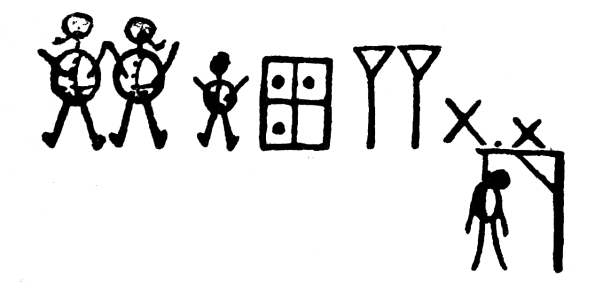
This is an exact copy of a bill sent by a bricklayer
to a gentleman for work done.
Date, 1798.
Title: The puzzle king
Amusing arithmetic, book-keeping blunders, commercial comicalities, curious "catches", peculiar problems, perplexing paradoxes, quaint questions, queer quibbles, school stories, interesting items, tricks with figures, cards, draughts, dice, dominoes, etc., etc., etc.
Author: John Scott
Release date: May 12, 2016 [eBook #52052]
Most recently updated: October 23, 2024
Language: English
Credits: Produced by MWS, Paul Marshall and the Online Distributed
Proofreading Team at http://www.pgdp.net (This file was
produced from images generously made available by The
Internet Archive)
“LAUGH AND GROW FAT.”
AMUSING ARITHMETIC.
BOOK-KEEPING BLUNDERS.
COMMERCIAL COMICALITIES.
CURIOUS “CATCHES.” PECULIAR PROBLEMS.
PERPLEXING PARADOXES.
QUAINT QUESTIONS. QUEER QUIBBLES.
SCHOOL STORIES.
INTERESTING ITEMS.
Tricks with Figures, Cards, Draughts, Dice, Dominoes,
Etc., Etc., Etc.
By JOHN SCOTT,
Author of “How to Become Quick at Figures,” “Doctrine of Chance,”
“Tank Calculator,” “Cyanide Vat Calculator,” &c., &c.
INSTRUCTIVE and AMUSING.
Copyright.
Brisbane,
H. J. Diddams & Co., Printers and Publishers, Elizabeth Street,
MDCCCXCIX.
[Pg 2]
It is hoped that this little book may prove useful, not only in connection with puzzles for home amusement, but that by inducing people to consider the various difficulties met with in business and trade some at least may be led to greater success in dealing with the practical puzzles and problems of everyday life.
It is the special desire of the author to produce a “sugar-coated mathematical pill,” as he feels convinced that many can more easily grasp the truth when it is put before them in a light manner than when brought forward in the usual orthodox fashion.
No pains have been spared to make the Puzzle King the best of its kind yet produced, and the author here wishes to thank his many friends who have so kindly assisted him. It would be well-nigh impossible to individualize; but especial thanks are due to Thos. Finney, Esq., M.L.A. (Brisbane), for the interest he has manifested throughout, and the kindly help he has so often rendered the author.
It might afford our readers some pleasure to know that this work is entirely Australian. The printers, artist, and author are all colonial-born, and the production of the former two, at any rate, will compare favourably with that of any others.
The engravings throughout have been in the hands of Mr. Murray Fraser and staff, whose experience in this special art has tended to make the book more attractive than it otherwise would have been.
The author is not above receiving any suggestions or contributions in the way of peculiar puzzles or commercial comicalities, which might enhance the value of the book. Intending contributors are invited to communicate to the address given below, and can rest assured that they will be remunerated according to the merits of their communications.
44, Pitt Street, Sydney. [Pg 3]
Refer to Appendix for Answers to numbered Problems.
Wonderful Calculations.
Although we are accustomed to speak in the most airy fashion of millions, billions, &c., and “rattle” off at a breath strings of figures, the fact still remains that we are unable to grasp their vastness. Man is finite—numbers are infinite!
ONE MILLION
Is beyond our conception. We can no more realise its immensity, than we can the tenth part of a second. It should be a pleasing fact to note that commercial calculations do not often extend beyond millions; generally speaking, it is in the realm of speculative calculation only, such as probability, astronomy, &c., that we are brought face to face with these unthinkable magnitudes.
Who, for instance, could form the slightest idea that the odds against a person tossing a coin in the air so as to bring a head 200 times in succession are
160693804425899027554196209234116260522202993782792835301375
(over I decillion, &c.) to 1 against him? Suppose that all the men, women and children on the face of the earth were to keep on tossing coins at the rate of a million a second for a million years, the odds would still be too great for us to realise against any one person succeeding in performing the above feat, and yet the number representing the odds would be only half as long as the one already given.
Or, who could understand the other equally astounding fact that Sirius, the Dog-star, is 130435000000000 miles from the earth, or even that the earth itself is 5426000000000000000000 tons in weight.
WHAT IS A BILLION
In Europe and America, the billion is 1,000,000,000—a thousand millions—but in Great Britain and her Colonies, a billion is reckoned 1,000,000,000,000—a million millions: a difference which should perhaps be worth remembering in the case of francs and dollars.
One billion sovereigns placed side by side would extend to a distance of over 18,000,000 miles, and make a band which would pass 736 times round the globe, or, if lying side by side, would form a golden belt around it over 26 ft. wide; if the sovereigns were placed on top of each other flatways, the golden column would be more than a million miles in height. [Pg 4]
Supposing you could count at the rate of 200 a minute; then, in one hour, you could count 12,000—if you were not interrupted. Well, 12,000 an hour would be 288,000 a day; and a year, or 365 days, would produce 105,120,000. But this would not allow you a single moment for sleep, or for any other business whatever. If Adam at the beginning of his existence, had begun to count, had continued to count, and were counting still, he would not even now, according to the usually supposed age of man, have counted nearly enough. To count a billion, he would require 9,512 years, 342 days, 5 hours and 20 minutes, according to the above reckoning. But suppose we were to allow the poor counter twelve hours daily for rest, eating and sleeping, he would need 19,025 years, 319 days, 10 hours and 40 minutes to count one billion.
A comparison—
One million seconds = less than 12 days
" billion " = over 31,000 years
A GOOD CATCH.
1.—Ask a person to write, in figures, eleven thousand, eleven hundred and eleven. This often proves very amusing, few being able to write it correctly at first.
2.—If the eighth of £1 be 3s, what will the fifth of a £5 note be?
BOTHERSOME BILLS.
Defter at the anvil than at the desk was a village blacksmith who held a customer responsible for a little account running:
| To menden to broken sorspuns | 4 punse |
| To handl to a kleffr | 6 " |
| To pointen 3 iron skurrs | 3 " |
| To repairen a lanton | 2 " |
| A klapper to a bel | 8 " |
| Medsen attenden a cow sick the numoraman a bad i | 6 " |
| To arf a da elpen a fillup a taken in arvist | 1 shillin |
| To a hole da elpen a fillup a taken in arvist | 2 " |
| Totle of altigether | 5 shillins and fippunse. |
That the honest man’s services had been requisitioned for the mending of two saucepans, putting a new handle to an old cleaver, sharpening three blunted iron skewers, repairing a lantern, and providing a bell with a clapper is clear enough; and by resolving “a fillup” into “A. Phillip,” all obscurity is removed from the last two items, but “the numoraman a bad i” is a nut the reader must crack for himself. [Pg 5]
ONE FROM A PUBLICAN.
He stabled a horse for a night, and sent it home next day with a bill debiting the owner:
| To anos | 4/6 |
| To agitinonimom | -/6 |
| 5/- |
A LAUNDRY BILL.
A tourist in Tasmania, being called upon to pay a native dame of the wash-tub “OOo III,” opened his eyes and ejaculated, “O!” but the good woman explained that he owed her just two and ninepence, a big O standing for a shilling, a little one for sixpence, and each I for a penny.
THE DUTCHMAN’S ACCOUNT.
| Two wax dolls | 15/- |
| One wooden do | 7/6 |
| Total | 7/6 |
The two dolls were 7s 6d each, but one “wouldn’t do;” so, being returned, it was taken off the account in the above manner.
A carpenter in Melbourne who did a small job in an office, made out his bill:
To hanging one door and myself 14s.
A BILL MADE OUT BY A MAN WHO COULD NOT WRITE.

This is an exact copy of a bill sent by a bricklayer
to a gentleman for work done.
Date, 1798.
The bill reads thus: Two men and a boy, ¾ of a day, 2 hods of mortar, 10s 10d. Settled. [Pg 6]
A BILL FROM AN IRISH TAILOR.
To receipting a pair of trousers 5s.
QUITE RIGHT.
At a large manufactory a patent pump refused to work. Several engineers failed to discover the cause. The local plumber, however, succeeded, after a few minutes, in putting it in working order, and sent to the company—
| To Mending pump | 2 0 |
| " Knowing how | 5 0 0 |
| Total | £5 2 0 |
A VETERINARY SURGEON’S ACCOUNT.
To curing your pony, that died yesterday, £1 1s.
3. What is the number that the square of its half is equal to the number reversed?
HOW TO GET A HEAD-ACHE.

Naturalists state that snakes, when in danger, have been known to swallow each other; the above three snakes have just commenced to perform this operation. The snakes are from the same “hatch,” and are therefore equal in age, length, weight, &c. They all start at scratch—that is, commence swallowing simultaneously. They are twirling round at the express rate of 300 revolutions per minute, during which time the circumference is decreased by 1 inch.
We would like our readers to tell us what will be the final result? Heads or tails, and how many of each?
4. A man sold two horses for £100 each; he lost 25 per cent. on one, and gained 25 per cent. on the other. Was he “quits”; or did he lose or gain by the transaction; and, if so, how much? [Pg 7]
A GOOD CARD TRICK.
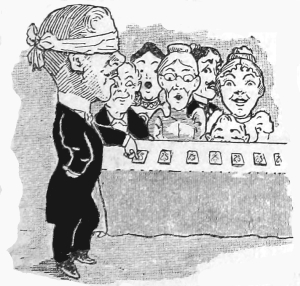
The performer lays upon the table ten cards, side by side, face downwards. Anyone is then at liberty (the performer meanwhile retiring from the room) to shift any number of the cards (from one to nine inclusive) from the right hand end of the row to the left, but retaining the order of the cards so shifted. The performer, on his return, makes a little speech: “Ladies and gentlemen, you have shifted a certain number of these cards. Now, I don’t intend to ask you a single question. By a simple mental calculation I can ascertain the number you have moved, and by my clairvoyant faculty, though the cards are face downwards, I shall pick out one corresponding with that number. Let me see” (pretends to calculate, and presently turns up a card representing “five”). “You shifted five cards and I have turned up a five, the exact number.”
The cards moved are not replaced, but the performer again retires, and a second person is invited to move a few more from right to left. Again the performer on his return takes up the correct card indicating the number shifted. The trick, unlike most others, may be repeated without fear of detection.
The principle is arithmetical. To begin with, the cards are arranged, unknown to the spectators, in the following order:
Ten, nine, eight, seven, six, five, four, three, two, one.
Such being the case, it will be found that, however many are shifted from right to left, the first card of the new row will indicate their number. Thus, suppose three are shifted. The new order of the cards will then be:
Three, two, one, ten, nine, eight, seven, six, five, four.
So far, the trick is easy enough, but the method of its continuance is a trifle more complicated. To tell the position of the indicating card after the second removal, the performer privately adds the number of that last turned up (in this case three) to its place in the row—one. That gives us four, the card to be turned up after the next shift will be the fourth. Thus, suppose six cards are now shifted, their new order will be:
Nine, eight, seven, six, five, four, three, two, one, ten.
Had five cards only been shifted, the five would have been fourth in the row, and so on. [Pg 8]
The performer now adds six, the number of the card, to its place in the row, four: the total, ten, gives him the position of the indicator for the next attempt. Thus, suppose four cards are next shifted, the new order will be:
Three, two, one, ten, nine, eight, seven, six, five, four.
The next calculation, 4 and 10, gives us a total 14. The ten is, in this case, cancelled, and the fourteen regarded as four, which will be found to be the correct indicator for the next shifting.
It looks more mystifying if the performer be blindfolded, for he can tell the position of the cards with his fingers. Keeping his hand on the card, he asks, “Will you please tell me how many cards were shifted?” As soon as the answer is given, he exhibits the card, and can continue the trick as long as he pleases.
5. Find 16 numbers in arithmetical progression (common difference 2) whose sum shall be equal to 7552, and arrange them in 4 columns, 4 numbers in each column—or, in other words, arrange in a square of 16 numbers that when added vertically, horizontally, or diagonally, the sum of each 4 numbers will amount to 1888.
If the number 37 be multiplied by 3, or any multiple of 3 up to 27, the product is expressed by three similar digits. Thus—
The products succeed each other in the order of the digits read downwards, 1, 2, 3, etc., these being multiplied by 3 (their number of places) reproduce the multiplicand of 37.
If it be multiplied by multiples of 3, beyond 27, this peculiarity is continued, except that the extreme figures taken together represent the multiple of 3 that is used as a multiplier. Thus—
The number 73 (which is 37 inverted) multiplied by each of the numbers of arithmetical progression 3, 6, 9, 12, 15, etc., produces products terminating (unit’s place) by one of the ten different figures, 1, 2, 3, 4, 5, 6, 7, 8, 9, 0. These figures will be found in the reverse order to that of the progression, 73 × 3 produces 9, by 6 produces 8, and 9 produces 7, and so on. [Pg 9]
Another number which falls under some mysterious law of series is 142,857, which, multiplied by 1, 2, 3, 4, 5, or 6 gives the same figures in the same order, beginning differently; but if multiplied by 7, gives all 9’s.
| 142,857 | multiplied by | 1 | = 142,857 |
| " | " | 2 | = 285,714 |
| " | " | 3 | = 428,571 |
| " | " | 4 | = 571,428 |
| " | " | 5 | = 714,285 |
| " | " | 6 | = 857,142 |
| " | " | 7 | = 999,999 |
Multiplied by 8, it gives 1,142,856, the first figure added to the last makes the original number—142,857.
The vulgar fraction 1⁄7 = ·142,857.
The following number, 526315789473684210, if multiplied as above, will, in the product, present the same peculiarities, as also will the number 3448275862068965517241379310.
| The multiplication of | 987654321 | by 45 | = 444444444445 |
| Do. | 123456789 | " 45 | = 5555555505 |
| Do. | 987654321 | " 54 | = 53333333334 |
| Do. | 123456789 | " 54 | = 6666666606 |
Taking the same multiplicand and multiplying by 27 (half 54) the product is 26,666,666,667, all 6’s except the extremes, which read the original multiplier (27). If 72 be used as a multiplier, a similar series of progression is produced.
6. In stables five, can you contrive to put in horses twenty— In each stable an odd horse, and not a stable empty?
“THREE THREES ARE TEN.”
This little trick often puzzles many:—
Place three matches, coins, or other articles on the table, and by picking each one up and placing it back three times, counting each time to finish with number 10, instead of 9. Pick up the first match and return it to the table saying 1; the same with the second and third, saying 2 and 3; repeat this counting 4; but the fifth match must be held in the hand, saying at the time it is picked up, 5; the other two are also picked up and held in hand, making 6 and 7; the three matches are then returned to the table as 8, 9, and 10. If done quickly few are able to see through it.
7. A man bought a colt for a certain sum and sold him 2 years afterwards for £50 14s., gaining thereby as much per cent. per annum compound interest as it had cost him. What was the original price? [Pg 10]
Do Figures Lie?
“Figures cannot lie,” is a very old saying. Nevertheless, we can all be deceived by them. Perhaps one of the best instances of them leading us astray is the following:—
An employer engaged two young men, A and B, and agreed to pay them wages at the rate of £100 per annum. A enquires if there is to be a “rise,” and is answered by the employer, “Yes, I will increase your wages £5 every six months.” “Oh! that is very small; it’s only £10 per year,” replied A. “Well,” said the employer, “I will double it, and give you a rise of £20 per year.” A accepts the situation on those terms.
B, in making his choice, prefers the £5 every six months. At the first glance, it would appear that A’s position was the better.
Now, let us see how much each receives up to the end of four years:—
| A | B | ||
| 1st year | £100 | 50} | 1st year |
| 2nd " | 120 | 55} | |
| 3rd " | 140 | 60} | 2nd " |
| 4th " | 160 | 65} | |
| 70} | 3rd " | ||
| 75} | |||
| 80} | 4th " | ||
| 85} | |||
| £520 | £540 | ||
A spieler at a Country Show amused the people with the following game:—He had 6 large dice, each of which was marked only on one face—the first with 1, the second 2, and so on to the sixth, which was marked 6. He held in his hand a bundle of notes, and offered to stake £100 to £1 if, in throwing these six dice, the six marked faces should come up only once, and the person attempting it to have 20 throws.
Though the proposal of the spieler does not on the first view appear very disadvantageous to those who wagered with him, it is certain there were a great many chances against them.
The six dice can come up 46,656 different ways, only one of which would give the marked faces; the odds, therefore, in doing this in one throw would be 46,655 to 1 against, but, as the player was allowed 20 throws, the probability of his succeeding would be—
20
46,656
To play an equal game, therefore, the spieler should have engaged to return 2332 times the money deposited. [Pg 11]
TREBLE RULE OF THREE.
If 70 dogs with 5 legs each catch 90 rabbits with 3 legs each in 25 minutes, how many legs must 80 rabbits have to get away from 50 dogs with 2 legs each in half an hour?
8. Suppose a greyhound makes 27 springs whilst a hare makes 25, and the springs are equal: if the hare is 50 springs before the hound at the start, in how many springs will the hound overtake the hare?
The first Arithmetic in English was written by Tonstal, Bishop of London, and printed by Pinson in 1552.
Two persons playing dominoes 10 hours a day and making 4 moves a minute could continue 118,000 years without exhausting all the combinations of the game.
A schoolmaster wrote the word “dozen” on the blackboard, and asked the pupils to each write a sentence containing the word. He was somewhat taken aback to find on one of the slates the following unique sentence: “I dozen know my lesson.”
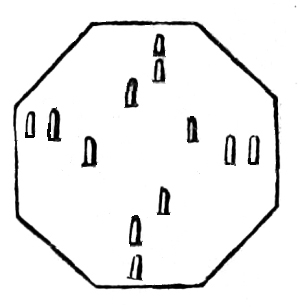
At an examination in arithmetic, a little boy was asked “what two and two made?” Answer—“Four.” “Two and four?” Answer—“Six.” “Two and six?” Answer—“Half-a-crown.”
10. A certain gentleman dying left his executor the sum of £3,000 to be disposed of in the following manner, viz.:—To give to his son £1,000, to his wife £1,000, to his sister £1,000, and to his sister’s son £1,000, to his mother’s grandson £1,000, to his own father and mother £1,000, and to his wife’s own father and mother £1,000—required, the scheme of kindred. [Pg 12]
COPY OF LETTER FROM FIRM TO COMMERCIAL TRAVELLER.
Mr. Einstein, Townsville,
Dear Sir,
Ve hav receved your letter on the 18th mit expense agount and round list. vat ve vants is orders, ve haf plenty maps in Sydney vrom vich to make up round lists also big families to make expenses.
Mr. Einstein ve find in going through your expenses agount 10s. for pilliards please don’t buy no more pilliards for us. vat ve vants is orders, also ve do see 30s. for a Horse and Buggy, vere is de horse and vot haf you done mit de Buggy the rest on your expenses agount vas nix but drinks—vy don’t you suck ice. ve sended you to day two boxes cigars, 1 costed 6/- and the oder 3/6 you can smoke the 6/- box, but gif de oders to your gustomers, ve send you also samples of a necktie vat costed us 28/- gross, sell dem for 30/- dozen if you can’t get 30/- take 8/6, vat ve vants is orders. The neckties is a novelty as ve hav dem in stock for seven years and ain’d sold none. My brother Louis says you should stop in Rockhampton. His cousin Marks livs dere. Louis says you should sell Marks a good bill; dry him mit de neckties first, and sell mostly for cash, he is Louis’s cousin. Ve only giv credit to dem gustomers vat pays cash. Don’t date any more bills ahead, as the days are longer in the summer as in the vinter. Don’t show Marks any of the good sellers, and finaly remember Mr. Einstein mit us veder you do bisness or you do nothings at all vat ve vants is orders.
P.S.—Keep the expenses down.
11. Two fathers and two sons went into a hotel to have drinks, which amounted to one shilling. They each spent the same amount. How much did each pay?
12. In a cricket match, a side of 11 men made a certain number of runs. One obtained one-eighth of the number, each of two others one-tenth, and each of three others one-twentieth. The rest made up among them 126 (the remainder of the score), and four of the last scored five times as many as the others. What was the whole number of runs, and the score of each man? [Pg 13]
BRAINS v. BRAWN.

Schoolmaster—“What is meant by mental occupation?”
Pupil—“One in which we use our minds.”
Schoolmaster—“And a manual occupation?”
Pupil—“One in which we use our hands.”
Schoolmaster—“Now, which of these occupations is mine. Come, now; what do I use most in teaching you?”
Pupil (quickly)—“Your cane, sir!”
MAGIC ADDITION.
To write the answer of an addition sum, when only one line has been written.

Tell a person to write down a row of figures. Now, this row will constitute the main body of the answer. Tell him to write another row beneath it; you now write a row also, matching his second row in pairs of 9’s he writes one more row, and you again supply another in the same manner. Your addition sum will now consist of five lines, four of which are paired; the first line, or key line, being the answer to the sum.
From the unit figure in the key line deduct the number of pairs of 9’s—in this instance two—and place the remainder, 6, as the unit figure of the answer, then write in order the rest of the figures in the key line, annexing the 2 to the extreme left; this will constitute the complete answer.
It, of course, is not necessary to adhere to two pairs of 9’s; there may be three, four, or even more; but the total number of lines, including the key line, must be odd, and the number of pairs must be deducted from the unit figure of the key line, and this same number be written down at the extreme left. The number of figures in each line should always be the same. As the location of the key line may be changed if necessary, the artifice could not easily be detected.
Punctuation was first used in literature in the year 1520. Before that time wordsandsentenceswereputtogetherlikethis. [Pg 14]

13. Smith and Brown meet a dairymaid with a pail containing milk. Smith maintains that it is exactly half full; Brown that it is not. The result is a wager. They have no instrument of any kind, nor can they procure one by means of which to decide the wager; nevertheless they manage to find out accurately, and without assistance, whether the pail is half-full or not. How is it done?—It should be added that the pail is true in every direction.
A HINT FOR TAILORS.
“There, stand in that position, please, and look straight at that notice while I take your measure.”
Customer reads the notice—
“Terms Cash.”
NUMBER 9.
If two numbers divisible by 9 be added together the sum of the figures in the amount will be either 9 or a number divisible by 9.
| Example: | 54 |
| (1) | 36 |
| 90 |
If one number divisible by 9 be subtracted from another number divisible by 9, the remainder will be either a 9 or a number divisible by 9.
| Example: | 72 |
| (2) | 18 |
| 54 |
If one number divisible by 9 be multiplied by another number divisible by 9, the product will be divisible by 9.
| Example: | 54 |
| (3) | 27 |
| 1458 |
[Pg 15] If one number divisible by 9 be divided by another number divisible by 9, the quotient will be divisible by 9.
| Example: | 27 | ) 3645 |
| (4) | ||
| 135 |
In the above examples it is worth noting that the figures in each answer added together continually produce 9.
(1) 90 = 9 (2) 54 = 9 (3) 1458 = 18 = 9 (4) 135 = 9
Also, if these answers be multiplied by any number whatever, a similar result will be produced.
Example: 135 x 8 = 1080 = 9
If any row of two or more figures be reversed and subtracted from itself, the figures composing the remainder will, when added, be a multiple of 9, and if added together continually will result in 9.
| Example: | 7362 | |
| 2637 | ||
| 4725 | = 18 = 9 |
Tell a person to write a row of figures, then to add them together, and to subtract the total from the row first written, then to cross out any one of the figures in the answer, and to add the remaining figures in the answer together, omitting the figure crossed out; if the total be now told, it is easy to discover the figure crossed out.
| Example: | 4367256 | = 33 |
| 33 | ||
| 4367223 | = 27 |
It should be observed that the figures of the answer to the subtraction when added together equal 27—a multiple of 9; this, of course, is always the case. Now, suppose that 7 was the figure crossed out, then the sum of the figures in the answer (omitting 7) would be 20; this number being told by the person, it is easily seen that 7 must have been crossed out, as that figure is required to complete the multiple 27. If after the figure has been crossed out, the remaining figures total a multiple of 9, it is evident that either a cipher or a 9 must have been the figure erased.
Multiply the digits—omitting 8—by any multiple of 9, and the product will consist of that multiple,
| Example: | 12345679 | 36= 4 x 9 |
| 36 | ||
| 444444444 |
If a figure with a number of ciphers attached to it be divided by 9, the quotient will be composed of that figure only repeated as many times as there are ciphers in the dividend; with the same figure as the remainder.
| Example: | 9 | ) 7000000 |
| ———— | ||
| 777777 - 7 |
EXCUSES.
“Miss Brown,—You must stop teach my Lizzie fisical torture. She needs reading and figgers more an that. If I want her to do jumpin I kin make her jump.”
“Please let Willie home at 3 o’clock. I take him out for a little pleasure, to see his father’s grave.”
“Dear Teecher,—Please excuse John for staying home—he had the meesels to oblige his father.”
“Dear Miss——, Please excuse my boy scratching hisself, he’s got a new flannel shirt on.”
“A country schoolmaster received from a small boy a slip of paper which was supposed to contain an excuse for the non-attendance of the boy’s brother. He examined the paper, and saw thereon:
“Kepatomtogoataturing.”
Unable to understand, the small boy explained to the master that his big brother had been “kept at home to go taturing”—that is, to dig potatoes.
“Tommy,” said the school teacher, “you must get your father to give you an excuse the next time you stay away from school.”
“That’s no use, teacher. Dad’s no good at making excuses; mother bowls him out every time.”
HARVESTING.
14. A and B engage to reap a field for 90s. A could reap it in 9 days by himself; they promised to complete it in five days; they found, however, that they were obliged to call in C (an inferior workman) to assist them the last two days, in consequence of which B received 3s. 9d. less than he otherwise would have done. In what time could B and C reap the field alone?
15. A man has a triangular block of land, the largest side being 136 chains, and each of the other sides 68 chains. What is the value of the grass on it, at the rate of £2 an acre?
A school inspector in the North of Ireland was once examining a geography class, and asked the question:
“What is a lake?”
He was much amused when a little fellow, evidently a true gem of the emerald isle, answered: “It’s a hole in a can, sur.” [Pg 17]
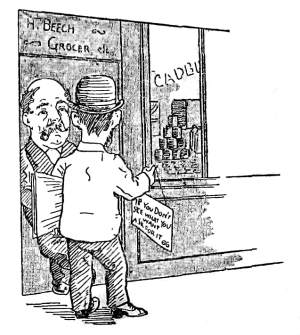
Canvasser—“I’ve got some signs that I’m selling to shopkeepers all day long. Everybody buys ’em. Here’s one—“If You Don’t See What You Want, Ask For It.”
Country Shopkeeper—“Think I want to be bothered with people
asking for things I ain’t got. Give me one reading “Ef Yeh Don’t See
What Yeh Want, Ask Fer Something Else.”
16. The number of soldiers placed at a review is such that they could be formed into 4 hollow squares, each 4 deep, and contain 24 men in the front rank more than when formed into a solid square. Find the whole number.
In the counting-house of an Irishman the following notice is exhibited in a conspicuous place: “Persons having no business in this office will please get it done as soon as possible and leave.”
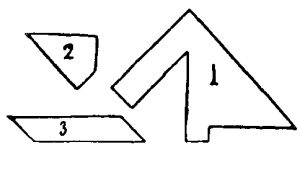
“I was induced to-day, by the importunity of your traveller,” wrote an up-country store-keeper to a Brisbane firm, “to give him an order; but, as I did it merely to get rid of him in a civil manner, and to prevent my losing any more time, I must ask you to cancel the same.”
A CATCH IN EUCHRE.
18. What card in the game of euchre is always trumps and yet never turned up? This often puzzles many. [Pg 18]
RELIGIOUS RECKONING.—(The New Jerusalem.)
Revelations xxi. (15)—“And he that talked with me had a golden rule to measure the city and the gates thereof and the wall thereof;
(16) “And the city lieth four square, and the length is as large as the breadth, and he measured the city with the reed twelve thousand furlongs. The length and the breadth and the height of it are equal.”
12,000 furlongs = 7,920,000 feet, which cubed = 496793088000000000000 cubic feet; half of this we will reserve for the Throne and Court of Heaven, and half the balance for streets, &c., leaving a remainder of 124198272000000000000 cubic feet. Divide this by 4096 (the cubic feet in a room 16 feet square) and there will be 3032184375 000000 rooms. Suppose that the world always did and always will contain 990,000,000 inhabitants, and that a generation lasts 33⅓ years, making in all 2,970,000,000 every century, and that the world will stand 100,000 years, totalling 2,970,000,000,000 inhabitants; then suppose there were 100 worlds equal to this in number of inhabitants and duration of years, making a total of 297,000,000,000,000 persons. There would then be more than 100 rooms 16 feet square for each person.
19. A man had a certain number of £’s, which he divided among 4 men. To the first he gave a part, to the second one-third of what was left after the first’s share, to the third he gave five-eighths of what was left, and to the fourth the balance, which equalled two-fifths of the first man’s share. How much money did he have, and how much did each receive, none receiving as much as £20?
ROWING AGAINST TIME.
20. In a time race, one boat is rowed over the course at an average pace of 4 yards per second, another moves over the first half of the course at the rate of 3½ yards per second, and over the last half at 4½ yards per second, reaching the winning post 15 seconds later than the first. Find time taken by each.
STOCK-BREEDING.
21. A farmer, being asked what number of animals he kept, answered: “They’re all horses but two, all sheep but two, and all pigs but two.” How many had he?
A QUIBBLE.
22. What is the difference between twice one hundred and five, and twice one hundred, and ten?
23. The product of two numbers is six times their sum, and the sum of their squares is 325. What are the numbers? [Pg 19]
THE PUZZLE ABOUT THE “PER CENTS.”
There are many persons engaged in business who often become badly mixed when they attempt to handle the subject of per centages. The ascending scale is easy enough: 5 added to 20 is a gain of 25%; given any sum of figures the doubling of it is an addition of 100%. But the moment the change is a decreasing calculation the inexperienced mathematician betrays himself, and even the expert is apt to stumble or go astray. An advance from 20 to 25 is an increase of 25%; but the reverse of this, that is, a decline from 25 to 20 is a decrease of only 20%.
There are many persons, otherwise intelligent, who cannot see why the reduction of 100 to 50 is not a decrease of 100%, if an advance from 50 to 100 is an increase of 100%.
The other day, an article of merchandise which had been purchased at 10 pence a pound was resold at 30 pence a pound—an advance of 200%. Whereupon, a writer in chronicling the sale said that at the beginning of the recent depression several invoices of the same class of goods which had cost over 30 pence per pound had been finally sold at 10 pence per pound—a loss of over 200%! Of course there cannot be a decrease or loss of more than 100%, because this wipes out the whole investment and makes the price nothing. An advance from 10 to 30 is a gain of 200%; but a decline of 30 to 10 is a loss of only 66⅔%.
A very deserving trader was ruined by his miscalculations respecting mercantile discounts. The article he manufactured he at first supplied to retail dealers at a large profit of about 30%. He afterwards confined his trade almost exclusively to large wholesale houses, to whom he charged the same price, but allowed a discount of 20%, believing that he was still realising 10% for his own profit. His trade was very extensive, and it was not till after some years that he discovered the fact that in place of making 10% profit, as he imagined, by this mode of making his sales he was realising only 4%. To £100 value of goods he added 30%, and invoiced them at £130. At the end of each month, in the settlement of accounts amounting to some thousands of pounds with individual houses, he deducted 20%, or £26 on each £130, leaving £104, value of goods at prime cost, instead of £110, as he all along expected.
24. Divide 75 into two parts so that three times the greater may exceed seven times the less by 15.
25. What number is that which, being divided by 7 and the quotient diminished by 10, three times the remainder shall be 24?
N.B.
“Trust men and they will trust you,” said Emerson. “Trust men and they will bust you,” says the business man. [Pg 20]
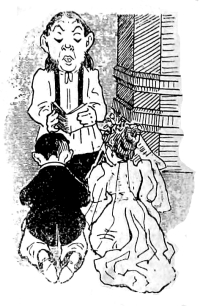
PECULIARITIES OF SQUARES.
The following is well worth examining:—
| 22. | equals | 1 | plus | 2 | plus | 1 | equals | 4 |
| 32. | " | 4 | " | 2 | " | 3 | " | 9 |
| 42 | " | 9 | " | 2 | " | 5 | " | 16 |
| 52. | " | 16 | " | 2 | " | 7 | " | 25 |
| 62. | " | 25 | " | 2 | " | 9 | " | 36 |
| 72. | " | 36 | " | 2 | " | 11 | " | 49 |
| 82. | " | 49 | " | 2 | " | 13 | " | 64 |
| 92. | " | 64 | " | 2 | " | 15 | " | 81 |
| 102. | " | 81 | " | 2 | " | 17 | " | 100 |
| 112. | " | 100 | " | 2 | " | 19 | " | 121 |
| 122. | " | 121 | " | 2 | " | 21 | " | 144 |
27. How many inches are there in the diagonal of a cubic foot? and how many square inches in a superficies made by a plane through two opposite edges of the cube?
Father (who has helped his son in his arithmetic at home)—“What did the teacher remark when you showed him your sums?”
Johnny—“He said I was getting more stupid every day.”
A “CATCH.”
28. 2 plus 2 = 4
2 x 2 = 4 The sum and product are alike.
Find another number that when added to itself the sum will equal its square. [Pg 21]
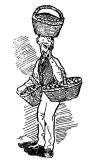
29. A man went to market with 3 baskets of oranges, which he sold at 6d. per dozen; after paying 2s. for refreshments and his coach fare, he had remaining 7s. The contents of the first and second baskets were equal to four times the first, and the contents of the first and half the third were together equal to the second; if he had sold the second and third baskets at 4d per dozen, he would have made as much money as he had now remaining. What was the coach fare?
30. A farmer has a triangular paddock, the sides of which are 900, 750, and 600 links; he requires to cut off 3 roods and 28 perches therefrom by a straight fence parallel to its least side. What distance must be taken on the largest and intermediate sides?
THE SOVEREIGNS OF ENGLAND.
By the aid of the following, the order of the kings and queens of England may be easily remembered:—
31. Take from 33 the fourth, fifth, and tenth parts of a certain number, and the remainder is 0. What is the number?
A WALKING MATCH.
32. T bets D he can walk 7 miles to his 6 for any time or distance; so they agree to walk a certain distance, starting from opposite points. T starts from point M to walk to N. D starts from N and walks to M. They both started at the same moment, and met at a spot 10 miles nearer to N than M. T arrives at N in 8 hours, and D arrives at M in 12½ hours after meeting. Who wins the wager? How far from M to N? And find the pace at which each walked? [Pg 22]
THE ALPHABET.
The total number of different combinations of the 26 letters of the alphabet is 403291461126605635584000000. All the inhabitants on the globe could not together, in a thousand million years, write out all the combinations, supposing that each wrote 40 pages daily, each page containing 40 different combinations of the letters.
“10 INTO 9 MUST GO.”
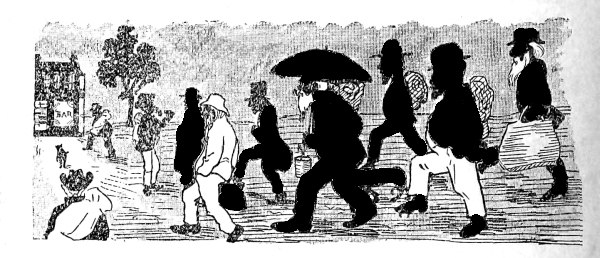
Bobby (just from school)—“Mamma, I’ve got through the promisecue-us examples, an’ I’m into dismal fractures.”
34. Find the expense of flooring a circular skating rink 30 feet in diameter at 2s. 3d. per square foot, leaving in the centre a space for a band kiosk in the shape of a regular hexagon, each side of which measures 24 inches.
35. Gold can be hammered so thin that a grain will make 56 square inches for leaf gilding. How many such leaves will make an inch thick if the weight of a cubic foot of gold is 12 cwt. 95 lbs.?
School Inspector: “What part of speech is the word “am”?
Smart Cockney Youth: “What? the ‘’am’ what you eat, sir, or the ’am‘ what you is?” [Pg 23]
MIND-READING WITH CARDS.
Hand the pack (a full one) to be shuffled by as many spectators as wish; then propose that someone takes the pack in his hand and secretly chooses a card, not removing it, but noticing at what number it stands counting from the bottom; he then returns the pack to you.
Now you have to tell what number the card is from the top. You ask any one of the spectators to choose any number between 40 and 50, and whatever number is chosen the card will appear at that number in the pack. Let us suppose the number chosen is 48.
You then say that it is not necessary for you to even see the cards, which will give you a good excuse for holding them under the table, or behind your back. Now subtract the number chosen, 48, from 52, which gives remainder 4, count off that many cards from the top, and place them at the bottom. You next say to the gentleman who chooses the card, that “it is now number 48, according to the general desire, would you please let us know at what number it originally stood?” Suppose he answers 7. Then, in order to save time, you commence counting from the top at that number, dealing off the cards one by one, calling the first card 7, the next 8, and so on. When you reach 48, it will be the card the gentleman had chosen. It is not necessary to limit the choice of position to between 40 and 50, but it is better for two reasons.
First, that the number chosen be higher than that at which the card first stood, also the higher the number chosen, the fewer cards are there to slip from the top to the bottom.

36. Divide a St. George cross, by two straight cuts, into four pieces, so that the pieces, when put together, will form a square.
PARSING.
“What part of speech is ‘kiss’?” asked the High School teacher.
“A conjunction,” replied one of the smart girls.
“Wrong,” said the teacher, severely. “Next girl.”
“A noun,” put in a demure maiden.
“What kind of a noun?” continued the teacher.
“Well—er—it is both common and proper,” answered the shy girl, and she was promoted to the head of the class.
“QUICK.”
Teacher (to class)—“What is velocity?”
Bright Youth—“Velocity is what a person puts a hot plate down with.” [Pg 24]
OFFICE RULES.
I. Gentlemen entering this Office will please leave the door wide open.
II. Those having no business will please call often, remain as long as possible, take a chair, make themselves comfortable, and gossip with the Clerks.
III. Gentlemen are requested to smoke, and expectorate on the floor, especially during Office Hours; Cigars and Newspapers supplied.
IV. The Money in this Office is not intended for business purposes—by no means—it is solely to lend. Please note this.
V. A Supply of Cash is always provided to Cash Cheques for all comers, and relieve Bank Clerks of their legitimate duties. Stamped cheque forms given gratis.
VI. Talk loud and whistle, especially when we are engaged; if this has not the desired effect, sing.
VII. The Clerks receive visits from their friends and their relatives; please don’t interrupt them with business matters when so engaged.
VIII. Gentlemen will please examine our letters, and jot down the Names and Addresses of our Customers, particularly if they are in the same profession.
IX. As we are always glad to see old friends, it will be particularly refreshing to receive visits and renewal of orders from any former Customer who has passed through the Bankruptcy Court, and paid us not more than Sixpence in the Pound. A Warm welcome may be relied on.
X. Having no occupation for our Office Boy, he is entirely at the service of callers.
XI. Our Telephone is always at the disposal of anyone desirous of using it.
XII. The following are kept at this
Office for Public Convenience:—
A Stock of Umbrellas
(silk), all the Local Newspapers, Railway Time Tables, and other
Guides and Directories; also a supply of Note Paper, Envelopes, and
Stamps.
XIII. Should you find our principals engaged, do not hesitate to interrupt them. No business can possibly be of greater importance than yours.
XIV. If you have the opportunity of overhearing any conversation, do not hesitate to listen. You may gain information which may be useful in the event of disputes arising.
XV. In case you wish to inspect our premises, kindly do so during wet weather, and carry your umbrella with you. We admire the effect on the floor; it gives an air of comfort to the establishment. (The Umbrella Stand is only for ornament, and on no account to be used).
P.S.—Our hours for listening to Commercial Travellers, Beggars, Hawkers, and Advertising Men are all day. We attend to our Business at Night only. [Pg 25]
A NEW WAY OF PUTTING IT.
Does the top of a carriage wheel move faster than the bottom? This question seems absurd. That the top moves faster, however, is perfectly correct; for if not it would simply move round in the same place: in a wheel on a fixed axle the bottom moves backward as fast as the top moves forward; but in a wheel that is going forward, drawn by a progressive axle, the bottom does not go back at all, but remains almost stationary until it is its turn to rise and go forward.
37. A General, arranging his army in a solid square, finds he has 284 men to spare, but on increasing the sides of the square by one man, he wants 25 men to complete the square. How many men has he?
“STEWING.”
38. A student reads two lines more of “Virgil” each day than he did the day before, and finds that, having read a certain quantity in 18 days, he will read at this rate the same quantity in the next 14 days. How much will he read in the whole time?
39. Two bootmakers who lived in the town of B., thrown out of employment, resolved to go to G., a town 24 miles north from B., where there is a large factory; one of them went straight on to G., but the other went first to C., a small township west of B., and then went direct to G., his whole journey being 45 miles. What is the distance from C. to G.?
40. A tree which grows each year 1 inch less than the previous year, grew a yard in the first year; the value of the tree at any time is equal to the number of pence in the cube of the number of yards of its height. What is the value of the tree when done growing?
THIS OFTEN “STICKS” PEOPLE UP.
41. What two odd numbers multiplied together make 7? [Pg 26]
MAGIC SQUARES.
A Magic Square is a series of figures arranged in the equal divisions of a square in such a manner that the figures in each row when added up, whether horizontally, vertically, or diagonally, form exactly the same sum.
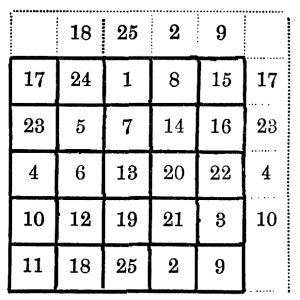
They have been called “Magic” because the ancients ascribed to them great virtues, and because this arrangement of numbers formed the basis and principle of their talismans. Archimedes devoted a great amount of attention to them, which has caused a great many to speak of them as “the squares of Archimedes.” They may be either odd or even. When the former, the following method will be found valuable:—
With the digits from 1 to 25 form a square so that the numbers when added up horizontally, vertically, or diagonally will amount to 65.
Method.—Imagine an exterior line of squares above the magic square you wish to form, and another on the right hand of it. These two imaginary lines are shown in the diagram.
1st. In placing the numbers in the square, we must go in the ascending diagonal direction from left to right, any number which, by pursuing this direction, would fall into the exterior line must be carried along that line of squares, whether vertical or horizontal, to the last square. Thus, 1 having been placed in the centre of the top row, 2 would fall into the exterior square above the fourth vertical line; then ascending diagonally 3 falls into the square diagonally from 2, but 4 falls out of it to the end of a horizontal line, and it must be carried along that line to the extreme left and there placed. Resuming our diagonal ascension to the right we place 5 where the reader sees it, and would place 6 in the middle of the top row, but as we find 1 is already there we look for the direction to
2nd. That when in ascending diagonally we come to a square already occupied, we must place the number which, according to the 1st rule should go into that occupied square directly under the last number placed: thus, in ascending with 4, 5, 6, the 6 must be placed under the 5, because the square next to 5 in diagonal direction is occupied.
A Promising Sign—I O U. [Pg 27]
HOW TO FIND THE TOTAL OF A ROW OF
FIGURES IN A MAGIC SQUARE.
Rule.—Multiply half the sum of the extremes by the square root of the greatest extreme.
Referring to the example given above, we see that the extremes 1 and 25 added equal 26—half of which is 13; this multiplied by 5 (the square root of 25) gives 65 as the total for each row.
Again, in the next question, the two extremes 1 and 81 equal 82, half of this sum is 41, which multiplied by 9 (the square root of 81) gives 369 as the total for each row.
42. Arrange the figures from 1 to 81 in a square that when added up horizontally, vertically, or diagonally the sum will be 369.
HOW THEY WORKED IT.
Mick and Pat, working in the country some distance from a hotel, arranged with the landlord to take to their hut a small keg of rum. They were unable to pay for the liquor at the time, having only one threepenny piece between them; but Mick proposed that every time he had a drink he would give Pat threepence, and Pat also agreed to pay Mick for his drinks, the cash thus gathered to be brought to the publican when the keg was empty. This proposal was accepted by the publican, the keg of rum handed over to the two Irishmen, who immediately started on their journey. They had not proceeded very far before their burden made them thirsty. Mick is the first to pull up with: “Hold on, Pat, I think I’ll have a drink.” “Begorra,” replied Pat, “you’ll have to pay me for it then.” Mick hands the 3d. to Pat before having a good “pull.” Pat now being the possessor of the price of a drink, slakes his thirst by paying Mick 3d. for it. This form of payment is kept up till the rum has disappeared. On their next visit to the hotel, the 3d piece is handed to the landlord as being payment, according to terms of agreement adopted by him.
43. Arrange the figure’s from 1 to 9 in a square, so that they will add up to 15, horizontally, vertically, or diagonally.

45. A man sold a horse for £35 and half as much as he gave for it, and gained thereby 10 guineas. What did he pay for the horse? [Pg 28]
THE DISHONEST SERVANT.
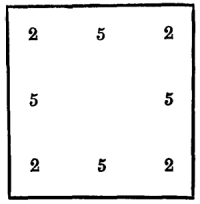
46. A gentleman having bought 28 bottles of wine, and suspecting his servant of tampering with the contents of the wine cellar, caused these bottles to be arranged in a bin in such a way as to count 9 bottles on each side. Nothwithstanding this precaution, the servant in two successive visits stole 8 bottles—4 each time—re-arranging the bottles each time so that they still counted 9 on a side. How did he do it?
Father—“You are very backward in your arithmetic. When I was your age I was doing cube roots.”
Boy—“What’s them?”
Father—“What! You don’t know what they are? My! my! that’s terrible! There, give me your pencil. Now, we take, say, 28764289, and find the cube root. First, you divide—no, you point off—no—let me see?—um—yes—no—don’t stand there grinning like a Cheshire cat; go upstairs and stay in your bedroom for an hour.”
A “TAKE-DOWN” WITH CARDS.
This is a card trick which depends upon a certain “key,” the possessor of which will always have the advantage over his uninstructed adversary. It is played with the first six of each suit—the four aces in one row, next row the deuces, threes, fours, fives and sixes. The object now will be to turn down cards alternately, and endeavour to make thirty-one points by so turning without over-running that number. The chief point is to count so as to end with the following numbers: 3, 10, 17 or 24.
For instance, we will suppose it your privilege to commence the count; you would commence with 3, and your adversary would add 6, which would make 9; it would be then your policy to add 1 and make 10; then, no matter what number he adds he cannot prevent you making 17, which gives you the command of the trick. We will suppose he adds 6 and make 16; then you add 1 and make 17; then he to add 6 and make 23, you add 1 and make 24; then he cannot add any number to make 31, as the highest number he can add is 6, which would only count 30, so that you can easily add the remaining 1 and make 31.
If your adversary is not wary, you may safely turn indifferent numbers at the beginning, trusting to his ignorance to let you count 17 or 24; but, as his knowledge increases, he will soon learn that 24 is a critical number, and to play for it accordingly.
If both players know the trick, the first to play must be the winner, as he is sure to begin with a 3, which commands the game. [Pg 29]
ON AN OFFICE DOOR IN GOULBURN.
47. There are 5 eggs on a dish; divide them amongst 5 persons so that each will get 1 egg and yet 1 still remain on the dish.
48. If a goose weighs 10 lbs. and a half of its own weight, what is the weight of the goose?
THE GEOMETRICAL WONDER AND ARITHMETICAL ABSURDITY.
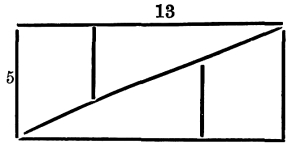
5 × 13 = 65 square inches.
Take a piece of cardboard 13 inches long and 5 wide, thus giving a surface of 65 inches. Cut this strip diagonally, giving two pieces in the shape of a triangle, and measure exactly 5 inches from the larger end of each strip and cut in two pieces. Take these strips and put them into the shape of an exact square, and it will appear to be just 8 inches each way, or 64 inches—a loss of one square inch of superficial measurement with no diminution of surface.
49. If we buy 20 sheep for 20 shillings, and give 2s. for wethers, 1s. 6d. for ewes, and 4d. for lambs, how many of each must we buy?
50. A sets out from a place and travels 5 miles an hour. B sets out 4½ hours after A and travels in the same direction 3 miles in the first hour, 3½ miles the second hour, 4 miles the third hour, and so on. In how many hours will B overtake A?
OFTEN ASKED.
51. What is the difference between 4 square miles and 4 miles square? [Pg 30]
TO TELL THE NUMBER THOUGHT OF ON A CLOCK.
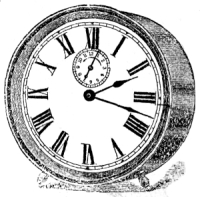
Ask a person to think of any number on the dial of a clock; you then point, promiscuously at the various numbers, telling the person to add the number of times you point to the number he thought of, and when the total reaches 20, you will be pointing at the number he selected.
For instance, suppose he selected the number 5. You point indifferently 7 times at the various numbers, but the 8th time your pointer must be at XII., his addition will then be 13 (for 5 and 8 added equal 13), the next at XI., his addition then 14, next at X., and so on. When he calls 20, you will be pointing at the number he thought of—5.
A very amusing experiment is to ask a person to write down the figures around the dial of a clock. Nearly all know that the figures are generally the Roman numerals; but, in writing them down, when they come to the four, it is very often written IV. instead of IIII.
It is said that a certain king, being unable to find any other fault in a clock that had been constructed for him, declared that the figure four should be represented by four strokes (IIII) instead of IV. In vain did the clock-maker point out the mistake, for his majesty adhered obstinately to his own opinion, and angrily ordered the alteration to be made. This was done, and the precedent thus formed has been followed by clockmakers ever since.
52. At dinner table: one great grandfather, 2 grandfathers, 1 grandmother, 3 fathers, 2 mothers, 4 children, 3 grandchildren, 1 great grandchild, 3 sisters, 1 brother, 2 husbands, 2 wives, 1 mother-in-law, 1 father-in-law, 2 brothers-in-law, 3 sisters-in-law, 2 uncles, 3 aunts, 1 nephew, 2 nieces, and 2 cousins. How many persons?
PANCAKE DAY.
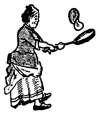
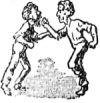

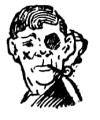
[1] Inches.
A Great Prophet—100 per cent. [Pg 32]
The reason why February has only 28 days, while the other months have 30 and 31 is attributable to the vanity of the Emperor Augustus. His uncle and predecessor corrected the calendar, arranging the year almost as we have it now; he gave to the year 12 months, or 365¼ days. The months were—March (the first month), April, May, June, Quintilis, Sextiles, September, October, November, December, January, and February (the latter being the last month of the year, which among the Romans had consisted originally of 10 months). Cæsar ordered that the year should begin with January, and divided the days among them thus: January, March, May, Quintilis, September, and November each had 31 days; April, June, Sextiles, October and December had 30 days each; and February (the last month added to the year) had 29 days regularly and a 30th day every fourth year. After Julius Cæsar’s death, Mark Antony changed the name of Quintilis to July as we have it now. Augustus wanted a month for himself, and wanted it as long as his uncle’s month, so he took Sextiles for his and changed the name to August. Then he took February’s 29th day and added it to August, so that it might have 31 days; and, to avoid having 3 months of 31 days each in succession, September and November were reduced to 30 days, and October and December increased to 31 days each.
Previous to the year 1752, the legal year in England commenced on the 25th March. In that year it was enacted that the legal year should begin on 1st January. The change brought the calendar into unison with the actual state of the solar year. It is curious that in Scotland the change which made the legal year begin on January 1st was effected in 1600. For some time after the change in England, legal documents contained two dates for the period intervening between 1st January and 25th March—that of the old year and that of the new.
During the time of Oliver Cromwell, Christmas Day was described as a superstitious festival, and put down in England by the strong hand of the law.
There has been a superstitious notion that Fools’ Day dated back to the time of Noah’s Ark. The dove that was sent forth from the Ark is supposed to have returned on April 1st.
The Most Remarkable Month was February, 1866. It had no full moon. January had two full moons, and so had March, but February had none. This had not occurred since the creation of the world, and it will not occur again, so scientists tell us. [Pg 33]
All Fools’ Day had it’s origin in France, before the time of the Reformed Calendar. When the year commenced on March 25th, the French frequently paid their New Year’s visits and bestowed their gifts on April 1st, as March 25th occurred in Passion Week. After the adoption of the new calendar, however, these New Year’s observances took place on January 1st, and it was a common thing for people to forget the change of date. Pretended presents and mock ceremonial visits became common, and the persons thus imposed on were known as April fish, i.e., a mackerel, which, like a fool, is easily caught. Hence, All Fools’ Day.
54. Being at the summit of a tower 400 ft. high, I dropped a cricket ball from my hand, causing it to alight on a ledge 260 ft. from the base, over which it rolled and fell to the earth: supposing that 1½ seconds were occupied by the rolling of the ball over the ledge, how many seconds elapsed from the ball leaving my hand till it touched the earth, and what was the acquired velocity at the moment of contact?
PRACTICAL ILLUSTRATION.
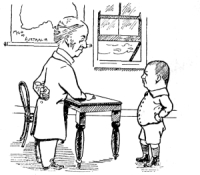
In one of our great public schools a master known to successive generations of his pupils for fifty years as “old Buggus” delighted in surprising his boys with strange sayings and doings. On one occasion, desirous of illustrating a question in the arithmetic lesson, he said to a boy, “I am a tripe merchant, and this platform is my shop. You will come here and buy a pound of tripe. Now, begin.”
“Please, I want a pound of tripe,” said a boy, sauntering up. “Where’s your money?” demanded old Buggus, hoping to put the boy out of countenance.
“Where’s your tripe?” was the ready retort; but it gained for its unfortunate author four hours’ detention on the next holiday.
55. A syphon would empty a cistern in 48 minutes, a tap would fill it in 36. How long will it take to fill the cistern when both taps are in action?
Born to rule—a book-keeper. [Pg 34]
“MORE HASTE LESS SPEED.”
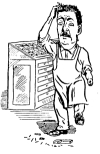
56. A compositor, hurrying whilst setting up type for an arithmetic book—“How to Become Quick at Figures”—accidentally dropped the work of a problem; unfortunately he mislaid the copy, and all that he remembered was that both multiplicand and multiplier consisted of two figures. The scattered type represented the following figures:—1, 2, 3, 3, 4, 6, 7, 8, 8, 9, 9. With the aid of a pencil and a piece of paper the compositor managed after a while to rearrange the figures in their proper place. What was the problem?
PROFITABLE CARELESSNESS.
A very amusing story is told of a harness-maker who lived some years ago in London. He had a handsome saddle in his shop, occupying a conspicuous position therein. On his return from luncheon one day he observed that the saddle was gone. Calling to his foreman, he said:
“John, who has bought the saddle?”
“I’m sure I don’t know, sir,” said the foreman, scratching his head as if he were trying to think. “I cannot tell, and the worst part of it is, it hasn’t been paid for. While I was at work in the back of the shop a gentleman came in, priced it, decided to take it, told me to charge it, and throwing it into his trap, drove off, before I could think to ask his name.”
“That was very stupid of you,” said the harness-maker, disposed to be angry at the man’s carelessness. “Very likely we have been robbed.”
“I don’t think that sir,” said the foreman, “for I’m very sure that the gentleman has traded here before.”
“Well, I can’t afford to lose the money,” said the harness-maker. “We’ll have to find out who took it and send him the bill. Ah!” he added, with a smile, after a moment’s reflection, “I have it. We’ll charge it up to the account of every one of our customers who keep open accounts here. Those who didn’t get it will refuse to pay, so we shall be all right.”
“The book-keeper was instructed to do this, and the bills in due course of time went out. Some weeks later the harness-maker asked the book-keeper if he had succeeded in discovering who the customer was.
“No, sir,” he replied, “and we never shall, I fear, sir, for about 40 people have paid for it already without saying a word.” [Pg 35]
A CYCLE CATCH.
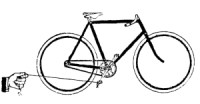
Tie a cord to the pedal of a bicycle, such pedal to be the one that is the nearer to the ground, and, standing behind the back wheel, pull the cord, when, strange as it appears, the machine will come towards you, although everyone would first imagine that the bicycle would move forward. How is this?
One ought to have dates at one’s finger ends seeing they grow upon the palms.
TO TELL THE SPOTS ON THE
BOTTOM CARDS OF SIX HEAPS.
Allow anyone to choose six cards from a full pack. Tell him the court cards count 10, and the other cards according to their pips. Having made his selection, tell him to lay the chosen cards upon the table face downwards, without allowing you to see them, and to place upon each as many cards as pips are required to make 12. Whilst he is doing so, you should be out of the room or blindfolded. On your return he hands you the cards left over, and you have to tell the total number of spots on the six bottom cards.
Suppose he had chosen 10, 6, 1, K, 3 and 7, which totals 37, now on the 10, he would place two cards to make 12; on the 6, he would place 6; and on the 1, 11 would be placed, and so on. On receiving the remaining cards from him you pretend to be looking through them carefully, but you simply want to know how many he has given you, which in the above example would be 11. To this number you add 26, which gives 37, the total spots required.
Should there not be enough cards left on hand to complete the six heaps, you can ask him how many cards he is short of, and this number, subtracted from 25, will give the total. It is better not to allow the person to choose six cards right off at the beginning, but for him to shuffle and cut the pack as he pleases, and to take the cards as they come.
BOOK-KEEPING COMMANDMENTS.
By Ledger laws, what I receive Is Debtor made to those who give. Stock for my debts must Debtor be, and Creditor by Property. Profit and Loss accounts are plain, I Debit loss and Credit gain.
57. How far does a man walk while planting a field of corn 285 feet square, the rows being 3 ft apart from the fence? [Pg 36]

A MATTER OF OPINION.
A man walks round a pole on the top of which is a monkey. As the man moves, the monkey turns on the top of the pole, so as still to keep face to face with the man. Now, when the man has gone round the pole, has he or has he not gone round the monkey?
TRY IT.
Take the number 15, multiply it by itself, and you have 225; now multiply 225 by itself, then multiply that product by itself, and so on until 15 products have been multiplied by themselves in turn. The final product called for contains 38,539 figures (the first of which is 1412). Allowing three figures to an inch, the answer would be over 1070 feet long. To perform the operation would require about 50,000,000 figures. If they can be made at the rate of 100 a minute, a person working 10 hours a day for 300 days in each year would be 28 years on the job.
PATHETIC ADVERTISING.
“Died, on the 11th ultimo., at his shop in Fleet-street, Mr. Edward Jones much regretted by all who knew and dealt with him. As a man, he was amiable; as a hatter, upright and moderate. His virtues were beyond all price, and his beaver hats were only £1 4s each. He has left a widow to deplore his loss, and a large stock to be sold cheap for the benefit of his family. He was snatched to the other world in the prime of life, and just as he had concluded an extensive purchase of felt, which he got so cheap that the widow can supply hats at a more moderate charge than any house in London. His disconsolate family will carry on his business with punctuality.”
58. In one corner of a hexagonal grass paddock each of the sides of which is 40 yards long, a horse is tethered with a rope 50 yards long. How many square yards can he graze over?
59. A and B start together from the same point on a circular path, and walk till they both arrive together at the starting point. If A performs the circuit in 224 seconds and B in 364 seconds, how many times do they each walk round?
“IF.”
If you could sell the sea at 1d. per 10,000 gallons, it would bring in 155 billion pounds. If you were to try and pump it dry, at the rate of 1,000 gallons per second, it would take 12,000 million years. There is always an “if” in these things! [Pg 37]

60. A lady met a gentleman in the street. The gentleman said “I think I know you.” The lady said he ought, as his mother was her mother’s only daughter. What relation was he?
A CRICKET “CATCH.”
61. In an eleven, when the ninth batsman goes in, how many wickets have to fall before all are out?
62. A boat’s crew can row eight miles an hour in still water; what is the speed of a river’s current if it takes them 2 hours and 40 minutes to row 8 miles up and 8 miles down?
BAD WRITING.
In a well-known firm in Sydney the clerks are presided over by a rather impetuous manager, whose violent fits of temper very often dominate his reason. For instance, the other day he was wiring into one of them about his bad work.
“Look here, Jones,” he thundered, “this won’t do. These figures are a perfect disgrace to a clerk! I could get an office boy to make better figures than those, and I tell you I won’t have it! Now, look at that five, it looks just like a three. What do you mean, sir, by making such beastly figures? Explain!”
“I—er beg your pardon, sir,” suggested the trembling clerk, his heart fluttering terribly, “but—er well, you see, sir, it is three.”
“A three?” roared the manager; “why, it looks just like a five!”
63. Write 24 with three equal figures, neither of them being 8.
THE WRONG COLUMN.
64. A clerk, while posting from day book to ledger, transposed an amount by placing the pence in the shilling column and the shillings in the pence column, thereby causing an error of 9s. 2d. With what amount could he make such a mistake? [Pg 38]
EDUCATIONAL VAGARIES.
Extracts from Reports of Country Provisional Schools.
School No. 1: On roll, 1 boy, 1 girl; total, 2. Average attendance, 0·6 boy, 0·6 girl; total, 1·2.
School No. 2: On roll, 2 boys, 2 girls; total 4. Average attendance, 1·6 boys, 1·3 girls; total, 2·9.
School No. 3: On roll, 2 boys, no girls. Average attendance, 0·8 boys.
By the above we see the public are paying for a teacher to provide education for eight-tenths of a boy!
A DISPUTE.
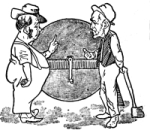
66. Two men have an equal interest in a grindstone, which is 5 ft. 6 in. in diameter. The centre of the stone, to the extent of a diameter of 18 in., is useless, and not to be taken into account.
Required to find the depth to which the first partner may be allowed to grind away from the stone in order to leave an equal share of the stone to the second partner.
BANK NOTE VERSE.
On the backs of bank notes one sometimes meets with strange and peculiar sentiments. “Go, poor devil, get thee gone,” is the kind of parting salutation most in favour; but the following is chiefly notable as a rare instance of the bank-note rhymester parting with his money in a Christian spirit:
An Irish merchant, who felt annoyed at a complaining letter he received from a customer, wrote back:—“We decline to acknowledge the receipt of yours of the 15th.”
If to-day is the to-morrow of yesterday, is to-day the yesterday of to-morrow? [Pg 39]
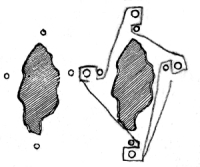
67. Suppose that four poor men build their houses around a pond, and that afterwards four evil-disposed rich men build houses at the back of the poor people—as shown in illustration—and wish to have a monopoly of the water: how can they erect a fence so as to shut the poor people off from the pond?
SOME TRADE SIGNS AND MOTTOES.
Many curious inscriptions are to be found displayed on shop windows, office doors, etc.
Here are a few:—
A Pawnbroker.—“Mine is a business of the greatest interest.”
A Flourishing Bootmaker.—“Don’t you wish you were in my shoes?”
A Publican.—“Good beer sold here, but don’t take my word for it.”
A Hairdresser.—“Two heads are better than one.”
A Carter.—“Excelsior—hire and hire.”
A Baker.—“The staff of life I do supply, by it you live and so must I.”
A Butcher.—“We kill to dress, not dress to kill.”
A Builder.—“I send innocent men to the ‘scaffold.’”
A Clerk.—“I possess more pens than pounds.”
A Dentist.—“I look ‘down in the mouth’ and am happy.”
A Doctor.—“I take pains to remove pains.”
A Hatter.—“I shelter ‘the heir apparent’ and protect ‘the crown.’“
A Photographer.—“Mine is a developing business and mounting rapidly.”
A Solicitor.—“I study the law—and the profits.”
An Undertaker.—“No complaints from our customers.”
RIVAL BUTCHERS.
T. Jones.—“Sausages, 3d. per lb.—to pay more is to be robbed.”
J. Smith.—“Sausages, 4d. per lb.—to pay less is to be poisoned.”
A French confectioner, proud of his English, and wishing to let his customers know that their wants would be attended to without delay, put out the notice, “Short weights here.” [Pg 40]
A shopkeeper in the old country had printed under his name “The little rascal.” When asked the meaning of this strange sign, he replied, “It distinguishes me from the rest of my trade, who are all great rascals.”
On an Office Door.—“Shut this door, and as soon as you have done talking on business, serve your mouth the same way.”
“SHE.”
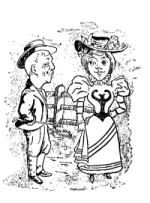
RUNNING SHORT.
69. A vessel on a 3 months’ trip has provisions for 4 months, but the stores are served out as if the voyage had to be completed in 3 months. At the end of 2 months, it is discovered that the voyage will take 3½ months. To what proportion must the rations be reduced for the remaining time?
In a certain town in the North of Queensland, a class of young men was formed to receive lessons in short methods of business arithmetic. The teacher was endeavouring to knock into the head of a young man that the cost of a dozen articles is the same number of shillings that a single article costs in pence. To illustrate the rule, he gave the following example:—
“If I buy 1 dozen apples at 1d each, then the dozen will cost 1 shilling; and if I buy 1 dozen oranges at 2 pence each, the dozen will cost 2 shillings. Now, supposing I buy 1 dozen at 3 pence each, how much will the dozen cost?”
Young Man (after two minutes’ reflection)—“Are they apples or oranges?” [Pg 41]
A DRAUGHTS PUZZLE.
70. Ten draughtsmen are placed in a row. The puzzle is to lift one up and passing over two at a time (neither more nor less) to place it on the top, or to “crown” the next one, continuing in this fashion until all are crowned. In passing over a piece already crowned, it is to be reckoned as two pieces.
71. In the centre of a pond 20 feet square there is a small island, on which is growing a tree. Two boys notice there is a bird’s nest on the top of the tree, but the difficulty is to reach the island, as they have 2 short planks that only measure 8 feet each. After a little while they hit on an ingenious plan, and, without nailing the planks together, manage to place them so they can reach the tree in safety. How did they do it?
Teacher—“Now, I want all the children to look at Tommy’s hands, and see how clean they are, and see if all of you cannot come to school with cleaner hands. Tommy, perhaps, will tell us how he keeps them so nice?”
Tommy—“Yes ’m; mother makes me wash the breakfast things every morning.”
BRAIN-BEWILDERERS.
An amusing periodical got up by the boys of a certain college gives a capital skit on the style of examination-papers frequently presented for the torture of pupils. Here are a few examples:—
Supposing the River Murray to be three cubits in breadth—which it isn’t—what is the average height of the Alps, stocks being at nineteen and a-half?
If in autumn apples cost fourpence per pound in Melbourne, and potatoes a shilling a score in spring, when will greengages be sold in Brisbane at three-halfpence each, Sydney oranges being at a discount of five per cent.?
If two men can kill twelve kangaroos in going up the right side of a rectangular turnip-field, how many would be killed by five men and a terrier pup in going down the other side?
If a milkmaid four feet ten inches in height, while sitting on a three-legged stool, took four pints of milk out of every fifteen cows, what was the size of the field in which the animals grazed, and what was the girl’s name, age, and the occupation of her grandfather?
If thirty thousand millions of human beings have lived since the beginning of the world, how many may we safely say will die before the end of it? N.B.—This example to be worked out by simple subtraction, algebra, and the rule of three. Compare results.
72. Find two numbers in the proportion of 9 to 7 such as the square of their sum shall be equal to the cube of their difference. [Pg 42]
A great deal of fun can be derived from puzzles of this nature—they are endless in variety—and as they depend upon some principle in arithmetic should be easily remembered.
| Example 1. | Think of a number, say | 5 |
| Double it | 10 | |
| Add 5 | 15 | |
| Add 12 | 27 | |
| Take away 3 | 24 | |
| Halve it | 12 | |
| Take away number first thought of—5 | ||
| The answer will always be | 7 |
| Example 2. | Think of a number, say | 8 |
| Square it | 64 | |
| Subtract the square of the number which is | ||
| 1 less than the number thought of—that | ||
| is 7—whose square is 49—leaves | 15 | |
| Add 1 | 16 |
When this last number is told, halve it, and you will arrive at the original number—8.
| Example 3. | Think of a number, say | 9 |
| Multiply by 3 | 27 | |
| Add 2 | 29 | |
| Multiply by 3 | 87 | |
| Add 2 more than the number thought of (11) | 98 |
The number of tens in the last answer gives the number thought of, viz., 9.
| Example 4. | Think of a number, say | 7 |
| Multiply by 3 | 21 | |
| [If product be odd] add 1 | 22 | |
| Halve it | 11 | |
| Multiply by 3 | 33 | |
| [If product be odd] add 1 | 34 | |
| Halve it | 17 |
Ask how many 9’s are in the remainder, when, of course, the reply will be 1.
The secret is to bear in mind whether the first sum be odd or even. If odd first time, retain 1 in the memory; if odd a second time, 2 more, making 3; to which add 4 for every 9 contained in the remainder.
In the above example, there being only one 9 in 17, this gives us 4, which added to 3 produces the number thought of—7. When even simply add 4 for every 9 in remainder. [Pg 43]
HOW TO TELL THE AGE OF A PERSON.
Tell a person to write down the figure which represents the day of the week on which he was born;—thus, 1 for Sunday, 2 for Monday, and so on; next, the figure for the month—1 for January, 2 for February, &c.; then the date of the month; now tell him to multiply the number thus formed by 2, add 5, multiply by 50, and then to add his age, and from this sum to subtract 365; now you ask him for the remainder, to which you secretly add 115.
The result will be:—The first figure, the day of the week; the next, the month in the year; the next, the date of the month; and the last, the age in years.
Example:
A person was born on Wednesday, 11th June, 1863.
Write 4, as Wednesday is 4th day of the week.
" 6, as June is 6th month of year.
" 11, as that is the date given, 11th June.
| The figures then are— | 4611 | Age |
| 2 | ||
| 9222 | ||
| 5 | ||
| 9227 | ||
| 50 | ||
| 461350 | ||
| 35 | ||
| 461385 | ||
| 365 | ||
| 461020 | ||
| 115 | ||
| 4-6-11-35 |
A GOOD FIGURE TRICK.
Tell a person to set down a sum of money less than £12, in which the pounds exceed the pence; next to reverse this amount, making pence pounds, etc., and to subtract the one from the other, then set beneath the result itself reversed, adding the last two lines together, when you will tell him the result, which will always be £12 18s. 11d.
| Example: | £10 8 7 |
| 7 8 10 | |
| 2 19 9 | |
| 9 19 2 | |
| £12 18 11 |
[Pg 44] If the performer be blindfolded the trick looks very mystifying; he should not, however, repeat it, for many would soon discover the secret, but as the peculiarity is not confined to money, other illustrations can be given if required—for instance—if a number of yds., ft. and inches (less than 12 yds.) be operated on, the final answer will always be 12 yds. 1 ft. 11 inches; and if a number of cwts., qrs. and lbs. (less than 28 cwts.) be chosen, the answer will always be 28 cwts. 2 qrs. 27 lbs.
“Girls” and “Boys.”
At a school examination, the inspector set the girls to write an essay on “Boys” and the boys to write one on “Girls.”
The following was handed in by a girl of 12:—
“The boy is not an animal, yet they can be heard to a considerable distance. When a boy hollers he opens his big mouth like frogs, but girls hold their tongues till they are spoken to, and then they answer respectable, and tell just how it was. A boy thinks himself clever because he can wade where it is deep, but God made the dry land for every living thing, and rested on the seventh day. When the boy grows up he is called a husband, and then he stops wading and stays out at nights, but the grew up girl is a widow and keeps house.”
One of the boys sent in:—
“Girls are very stuck up and dignified in their manners and behaveyour. They make fun of boys, and then turn round and love them. Girls are the only people that have their own way every time. Girls is of several thousand kinds, and sometimes one girl can be like several 1000 girls if she wants anything. I don’t beleive they ever killed a cat or anything. They look out every nite and say, “Oh, ain’t the moon lovely!” Thir is one thing I have not told, and that is they always now their lessons bettern boys. This is all I now about girls, and father says the less I now the better for me.”
73. The sum of the squares of two consecutive numbers is 1105. What are the numbers?
A PROBLEM FOR PLUMBERS.
74. A requires a tank in size capable of holding the quantity of water that would be caught from the roof of his house in a fall of 3 inches of rain. The roof (commonly called a “hip-roof”) is at an angle of 45 degrees to the wall plates. The length of house is 30 ft., breadth 24 ft., and length of ridge to roof 6 ft. But the eaves of the iron used for the roofing were so large as to increase its (the roof’s) dimensions by 3 inches all round, and the spouting added another 3 inches all round. Find the number of gallons the tank would require to contain; also dimensions of tank to be made so that its height must exceed its diameter by no more than 12 inches?
“The ’embers of a dying year”—November, December. [Pg 45]
TO TELL THE COMPASS BY A WATCH.
Hold the watch face-downwards above your head with the hour hand pointing towards the sun, and half-way between the hour hand and the figure XII will be the North.
75. Divide 100 into two parts, so that a quarter of one exceeds one-third of the other by 11.
STRANGE BUT TRUE.
76. Two persons were born at the same place at the same moment of time; after an age of 50 years they both died also at the same place and at the same instant, yet one had lived 100 days more than the other. How was this remarkable event achieved?
ASTRONOMICAL.
77. The planet Jupiter is five times further from the sun than our earth, and 1331 times larger. Assuming that the diameter of the earth is 7912 miles, find Jupiter’s diameter, circumference and area.
AN UNSOLVED PROBLEM.
One of the commercial questions of the day which remains to this time unsettled, is whether the fact of a gentleman having NO TIN may not have something to do with the answer he invariably sends of NOT IN when anyone calls on him with a bill.
78. Find nine numbers in arithmetical progression—common difference 3—whose sum is equal to 5670, and arrange in a square, each side containing three different numbers, so that, when added vertically, horizontally or diagonally, the sum of each three numbers will amount to 1890.
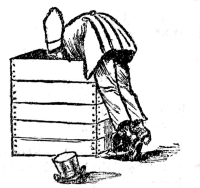
79. I have a box. The pieces forming the sides
are 5 ft long, and those forming the ends are 4 ft. broad. The box, when measured
externally all round, measures 18 ft 4 in., and when measured all round
internally, measures 17 ft 8 in. How can this be?
Teacher: “Who was it that supported the world on his shoulders?” Bright Pupil: “It was Atlas, ma’am.” Teacher: “And who supported Atlas?” Bright Pupil: “The book don’t say, but I s’pose it was his wife.” [Pg 46]
ON BOTH SIDES OF A DOOR
IN A MELBOURNE OFFICE.
THE MAN WHO FORGETS THE DOOR.
80. A man agrees to work for £8 a year and a suit of clothes. He left at the end of seven months, and received £2 13s. 4d. and his clothes. What is the value of the suit?
81. A bought four horses for £120. For the second he gave £3 more than for the first, for the third £2 more than for the second, and for the fourth £6 more than the third. Find price of each.

82. With eight pieces of card of the shape of figure A, four of figure B and four of figure C, and of proportionate sizes, form a perfect square.
83. Place four 5’s so that they shall express 6½.
“SHE” AGAIN.
SOME LONG WORDS.
The eight longest words in the language are philoprogenitiveness, incomprehensibleness, disproportionableness, transubstantiationalist, suticonstitutionalist, honourifibilitudinity, velocipedestrianistical, and proautionsubstantionist. The last four are not found in the best dictionaries, but that most hideous word, “Dacryocystosyringokatakleisis,” is in some of the new lexicons. [Pg 47]
HIS OWN GRANDFATHER.
The complication of relationship brought about by marriage is the cause of many a family squabble, but it is seldom one hears of fatal results attending such matters. According to an American newspaper, a resident of Pennsylvania committed suicide a few days ago from a melancholy conviction that he was his own grandfather.
The following is a copy of a singular letter he left:—“I married a widow who had a grown-up daughter. My father visited our house very often, fell in love with my step-daughter, and married her. So my father became my son-in-law and my step-daughter my mother, because she was my father’s wife. Some time afterwards my wife had a son; he was my father’s brother-in-law and my uncle, for he was the brother of my step-mother. My father’s wife—i.e., my step-daughter—had also a son; he was, of course, my brother, and in the meantime my grandchild, for he was the son of my daughter. My wife was my grandmother, because she was my mother’s mother. I was my wife’s husband and grandchild at the same time. And as the husband of a person’s grandmother is his grandfather, I was my own grandfather.” Thus he died, a martyr to his own existence.
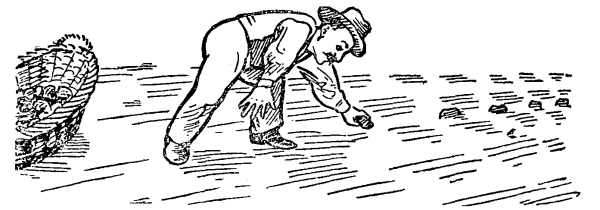
85. If 100 stones are placed on the ground, in a straight line, at the distance of 1 yard from each other, how far will a person travel who will bring them all, one by one, to a basket placed one yard from the first stone?
A little boy, writing a composition on the zebra, was requested to describe the animal and to mention what it was useful for. After deep reflection, he wrote:—“The zebra is like a horse, only striped. It is chiefly useful to illustrate the letter Z.”
86. I bought a horse and sold him again at 5 per cent. on my purchase; now, if I had given 5 per cent. less for the horse, and sold him for 1s. less, I would have gained 10 per cent. What was the original cost?
87. Find three numbers such that the first with half of the other two, the second with one-third of the other two, and the third with one-fourth of the other two, shall be equal to 34? [Pg 48]
THE FAMOUS “45” PUZZLE.
88. Take 45 from 45, and leave 45 as a remainder. There are at least two ways of doing this.
89. How can 45 be divided into 4 such parts that if you add 2 to the first part, subtract 2 from the second part, multiply the third part by 2, and divide the fourth part by 2, the sum of the addition, the remainder of the subtraction, the product of the multiplication, and the quotient of the division are equal?
90. The square of 45 is 2025, if we halve this we get 20⁄25 and 20 plus 25 equals 45. Find two other numbers of four figures that produce the same peculiarity.
91. A mother of a family being asked how many children she had, replied: “The joint ages of my husband and myself are at present six times the united ages of our children; two years ago their united ages were ten times less than ours, and in six years hence our joint ages will be three times theirs.” How many children had she?
WHERE THE CREEDS AGREE.

The Mahometans, Christians and Jews, with different creeds, are all striving to reach the same place—Heaven. Now, we will endeavour to show, by figures, that it is possible for them all to accomplish their purpose.
The figures 4, 5, 6, at the angles of the large triangle, represent respectively the above mentioned sects. They are very distant from each other, but we will induce them to meet half-way. Thus, the Mahometans and Jews meet at 10, the Mahometans and Christians at 9, and the Jews and Christians at 11; and by joining these totals to the opposite numbers we see they all meet at last in Heaven (15). It should be mentioned that any numbers whatever may be used to represent the sects, but the result will always be the same.
“SHE” ONCE MORE.
92. The country spark again addressed the charming “she.” This time he wished to know her height. She replied, “My height (in inches) if divided by the product of its digits, gives as quotient 2, and the digits are inverted by adding 27.” [Pg 49]
“You have a bright look, my boy,” said the visitor at the school. “Yes, sir,” replied the candid youth; “that’s because I forgot to rinse the soap off my face this morning.”
HIS LAST WILL AND TESTAMENT.
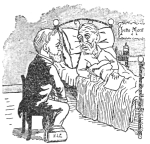
93. A father on his death-bed gave orders in his will that if his wife, who was then pregnant, brought forth a son, he should inherit two-thirds of his property, and the mother the remainder; but if she brought forth a daughter the latter should have only one-third, and the mother two-thirds. The widow, however, was delivered of twins,—a boy and a girl. What share ought each to have of the property left by the father, who had his life insured in the Australian Mutual Provident Society for £7,000.
A KEEN EYE TO BUSINESS.
Upon the death of the senior partner of an Australian firm a notice of the sad event was sent to, amongst others, a German lithographic establishment. The clerk in this German house, who was instructed to answer the communication, wrote the following letter of condolence:—
“We are greatly pained to hear of the loss sustained by your firm, and extend to you our heartiest sympathy. We notice the circular you sent us announcing Mr. S——’s death is lithographed by Messrs.——. We regret that you did not see your way to let us estimate for the printing of the same. The next time there is a bereavement in your house we will be glad to quote you for the lithographic circulars, and are confident that we can give you better work at less cost than anybody else in the business. Trusting that we may soon have an opportunity of quoting you our prices, we remain, with profound sympathy, yours truly,——.”
An American journal, describing a new counterfeit bank-note, says the vignette is “cattle and hogs, with a church far in the distance”—a good illustration of the world. [Pg 50]

95. On a square piece of paper mark 12 circles as shown in diagram. The puzzle is to divide the figure into four pieces of equal size, each piece to be of the same shape, and to contain three circles, without getting into any of them.
THE ORIGIN OF THE “STONE.”
Measurement of weight by the “stone” arose from the old custom farmers had of weighing wool with a stone. Every farmer kept a large stone at his farm for this purpose. When a dealer came along he balanced a plank on top of a wall, and put the stone on one end of it and the bags of wool on the other, until the weights were equal. At first the stones were of all sorts and sizes and weights, with the result that dealers who wished to make a living had to be remarkably knowing in their estimates of them. The many inconveniences involved by this inequality resulted in all stones being made of a uniform weight as far as wool was concerned. The weight of a stone of potatoes, meat, glass, cheese, &c., all differ.
A little boy was reading in his Scottish history an account of the battle of Bannockburn. He read as follows: “And when the English army saw the new army on the hill behind, their spirits became damped.”
The teacher asked him what was meant by “damping their spirits,” and the boy, not comprehending the meaning, simply answered, “Putting water in their whisky.”
THUNDER AND LIGHTNING CALCULATION.
96. Between the earth and a thundercloud there are four currents of air, having a temperature of 87, 57, 47, and 37 degrees respectively. The first current is half the depth of the second, the second half the third, and the third half the fourth. If a peal of thunder is heard 2-3251/4256 seconds after the lightning flash, find the depth of the fourth current and the time occupied by the sound in passing through it.
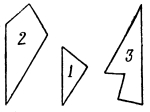
QUITE PROPER.
“What is a propaganda,” inquired the teacher. The boy looked at the ceiling, wrinkled his forehead, wrestled with the question a minute or two, and then answered that it was the brother of a proper goose.
DECEMBER AND MAY.
98. An old man married a young woman; their united ages amounted to 100; the man’s age, multiplied by 4 and divided by 9 gives the woman’s age. What were their respective ages?
99. A and B set out on a walking expedition at the same time—A from Melbourne to Geelong, and B from Geelong to Melbourne. On reaching Geelong A immediately starts again for Melbourne. Now, A arrives at Geelong four hours after meeting B, but he reaches Melbourne three hours after their second meeting. In what time did each perform the journey?
100. What two numbers are those of which the square of the first plus the second equals 11, and the square of the second plus the first equals 7?
A schoolmaster, describing a money-lender, says, “He serves you in the present tense, he lends you in the conditional mood, keeps you in the subjunctive mood, and ruins you in the future.”
101. “How much money have I,” says a father to his son. Son replied, “They don’t teach prophecy at our school.” “Well, they teach arithmetic, I suppose,” rejoined the father, smartly; “if you multiply one-half, one-third, one-fourth, one-sixth, three-quarters, and two-thirds of my money together, the product will be 10368. Now find out how many pence I have.”
102. A person has 1260 quarters of wheat. He sells one-fifth at a gain of 5 per cent., one-third at a gain of 8 per cent., and the remainder at a gain of 12 per cent. Had he sold the whole at a gain of 10 per cent. he would have made £23 2s. more than he did. Find the cost price of one quarter.
103. Is the word “with” ever used as a noun?
THE GREAT PUZZLE OF THE CENTURY.
104. Place the nine digits (1, 2, 3, 4, 5, 6, 7, 8, 9) together in such a manner that they will make 100.
105. Also make 100 by using the cipher in addition to the digits.
106. How far apart should the knots of a log-line be to indicate every half-minute, a speed of one mile per hour? [Pg 52]
107. Several persons are bound to pay the expenses of a law process, which amount to £800, but three of them being insolvent, the rest have £60 each to pay additional. How many persons were concerned?
109. A locomotive with a truck is travelling over a straight level line at the rate of 60 miles an hour. A man standing at the extreme rear of the truck casts a small stone into the air in a perpendicular direction. The stone travels upward at an average rate of 30 feet per second for 3 seconds; the height of the man’s hand from ground when the stone leaves is 15 feet. At what distance behind the train will the stone strike the ground in its descent?
A Tombstone in an English Cemetery.
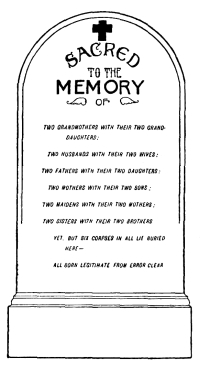
Many quaint and puzzling epitaphs are often to be seen engraved on several of the tombstones in some of the old cemeteries at Home. The adjoining illustration represents a tombstone in the old burial-ground of London—Kensal Green. It might “liven” up the reader to discover the scheme of kindred as given in the inscription.
SACRED TO THE MEMORY OF
TWO GRANDMOTHERS WITH THEIR TWO GRANDDAUGHTERS;
TWO HUSBANDS WITH THEIR TWO WIVES;
TWO FATHERS WITH THEIR TWO DAUGHTERS;
TWO MOTHERS WITH THEIR TWO SONS;
TWO MAIDENS WITH THEIR TWO MOTHERS;
TWO SISTERS WITH THEIR TWO BROTHERS
YET, BUT SIX CORPSES IN ALL LIE BURIED HERE—
ALL BORN LEGITIMATE FROM ERROR CLEAR.
EASILY ANSWERED.
“Johnny,” said his teacher, “if your father can do a piece of work in seven days, and your uncle George can do it in nine days, how long would it take both of them to do it?”
“They’d never get it done,” said Johnny; “they’d sit down and tell snake-yarns.”
110. A well is to be sunk by 12 men, in groups of 4 each, in 12 days. The groups work in the ratio of 6, 7, and 8; when half the task is done rain sets in and prevents them working for 2 days, in which time one man of the first, 2 of the second, and 3 of the third group go away, leaving the remainder to finish the job. What extra time did they work? [Pg 53]
“TAKE CARE OF THE PENCE, &c.”
One of the most startling calculations is the following:—
A penny at 5 per cent. compound interest from a.d. 1 to 1890 would amount to £10,000,000,000,000,000,000,000,000,000,000,000,000, i.e., Ten Sextillions of pounds, or more money than could be contained in One Thousand Millions of Globes each equal to the Earth in magnitude, and all of solid gold.
111. On a flagstaff consisting of an upright pole (6 feet of which is underground) is a cross-yard 24 feet long; the latter is fixed at a distance of one-third of the length of the visible part of the pole from the top; passing from the top of the pole to the ends of the yard are ropes, forming stays whose falls or ends reach to the ground on either side of the pole, and it is found that these falls just reach the base of the pole. The total length of rope in the aforesaid stays is 40 feet. Supposing that the top diameter of the pole is one-third of that at the extreme base, and that the whole length of rope used is 54,177 times the base diameter of the pole, what would the pole cost at 1 penny per 100 cubic inches?
Teacher—“Your writing is fairly good, but how do you account for making so many mistakes in your spelling?”
Scholar—“Please, ma’am, I had chilblains on my hand?”
112. Put down 4 marks ( | | | | ), and then require a person to put 5 more marks and make 10.
“KEEP YOUR HAIR ON.”
113. Supposing there are more persons in the world than anyone has hairs on his head, there must be at least two persons who have the same number of hairs on the head to a hair. Explain this.
114. Show what is wrong in the following:—
8-8 = 2-2, dividing both these equals by 2-2 the result must be equal; 8-8 divided by 2-2 = 4, and 2-2 divided by 2-2 = 1, therefore, since the quotients of equals divided by equals must be equal, 4 must be equal to 1.
“GLAD TIDINGS.”
Many will be surprised to hear that there is Scriptural authority for advertising. Advertising not only has Scriptural authority, but it is of very respectable antiquity as well. If you will look in Numbers XXIV., 14, you will find Balaam saying “Come now, and I will advertise,” and Boaz says in Ruth IV., 4, “And I thought to advertise.” [Pg 54]
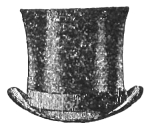
Illusions of the Eye are numberless, and afford a wide field for experiment. Some people are left-eyed, others right-eyed, and very few use both eyes equally. It is impossible to tell how far they really do deceive us unless they have been tested in the proper manner. For instance, if you ask anyone to what height a bell-topper would reach if placed on the floor against the wall, nine times out of ten the height guessed will be half as much again as the real height of the hat. Everyone seems to over-estimate the proper height.
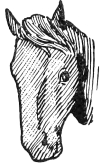
Another favourite illusion is to ask a person to mark on the wall a height from the floor which would represent the length of a horse’s head: here the majority guess far too little—for a horse’s head is much longer than most people imagine, ranging from 25 to 34 inches. In a recent experiment 5 persons out of 6 under-estimated the proper height.

Here are two triangles. Which is the one whose centre is the better indicated? (It looks like A, but it is B).
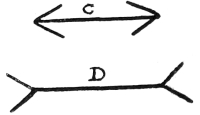
Again: Out of the two straight lines C and D which is the longer? (By measurement we see they are both the same).
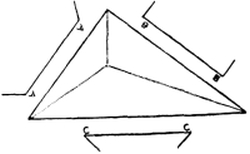
Guess, by eye-measurement only, the longest and shortest of the three lines marked A A, B B, and C C. When you have done guessing measure, and see how much you are out. [Pg 55]
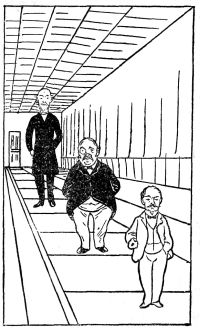
Which is the tallest gentleman of the three appearing in adjoining
figure?—Many would imagine the last to be the tallest, and the
first the shortest, whereas the reverse is the case—the last is the
shortest, and the first the tallest.
It is surprising how the eye can be deceived, when dealing with areas or circles. Place on the table a half-crown and a threepenny-piece; let these be, say, 9 or 10 inches apart, and ask a friend how many of the latter can be placed on the former—with this proviso: the threepenny-pieces must not rest on each other, nor must they overlap the outer rim of the half-crown; they must be fairly within the circumference of the larger coin. Many will answer 6, 5, or 4, others who are more cautious 3. Try for yourself and see how many you can put on, and you are sure to be surprised.

ARE THESE LINES PARALLEL?
The “herring-bone” figure here illustrated is yet another proof that our eyes are faulty. The horizontal lines appear to slant in the direction in which the short intersecting lines are falling, and would give one the idea that they would meet if continued, whereas really they are parallel. The illusion is more striking if you tilt the leaf up. [Pg 56]
HOW DID HE DO IT.
115. Once there was an old tramp who had to go through a tollbar, and before he could get through he had to pay a penny. He had not a penny; he did not find a penny, nor borrow a penny, nor steal nor beg a penny, and yet he paid a penny and went through.
116. Find a number which is such that if four times its square be diminished by 6 times the number itself the remainder shall be 70.
117. A man has a certain number of apples; he sells half the number and one more to one person, half the remainder and one more to a second person, half the remainder and one more to a third person, half the remainder and one more to a fourth person, by which time he had disposed of all that he had. How many had he?
Teacher (impressing one of her protégés)—“Be brave and earnest and you will succeed. Do you remember my telling you of the great difficulty ‘George Washington’ had to contend with?”
Willy Raggs—“Yes, mum; he couldn’t tell a lie.”
118. Two numbers are in the ratio of 2 and 3, and if 9 be added to each they are in the ratio of 3 to 4. Find the numbers.
PAYING A DEBT.
In an office the boy owed one of the clerks threepence, the clerk owed the cashier twopence, and the cashier owed the boy twopence. One day the boy, having a penny, decided to diminish his debt, and gave the penny to the clerk, who in turn paid half his debt by giving it to the cashier, the latter gave it back to the boy, saying, “That makes one penny I owe you now;” the office boy again passed it to the clerk, who passed it to the cashier, who in turn passed it back to the boy, and the boy discharged his entire debt by handing it over to the clerk, thereby squaring all accounts.
A TESTIMONIAL.
“How do you like your new typewriter?” inquired the agent.
“It’s grand!” was the immediate and enthusiastic response. “I wonder how I ever got along without it.”
“Well, would you mind giving me a little testimonial to that effect?”
“Certainly not; do it gladly.”
(A few minutes’ pounding). “How’ll this suit you?”
“afted Using the automatig Back-action a type writ, er for thre emonthan d Over. I unhesittattingly pronounce it prono nce it to be al even more than th e Manufacturs claim? for it. During the time been in our possession e. i. th ree monthzi id has more th an than paid for it£elf in the saving of time an d labrr?
STATE OF THE POLL.
119. In a constituency in which each elector may vote for 2 candidates half of the constituency vote for A, but divide their votes among B, C, D and E in the proportion of 4, 3, 2, 1; half the remainder vote for B, and divide their votes between C, D, E in proportion 3, 1, 1; two-thirds of the remainder vote for D and E, and 540 do not vote at all. Find state of poll, and number of electors on roll.
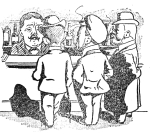
120. Three men, A, B and C, go into an hotel to have a “free and easy” on their own account, and after sundry glasses of Dewar’s Whisky got into dispute as to who had the most cash, and neither being willing to show his hand, the landlord was called upon to umpire. He found that A’s money and half of B’s added to one-third of C’s just came to £32, again that one-third of A’s with one-fourth of B’s and one-fifth of C’s made up £15, again he found that one-fourth of A’s together with one-fifth of B’s and one-sixth of C’s totalled £12. How much had each?
THE BIBLE IN SCHOOLS.
Visiting Clergyman—“What’s a miracle?”
Boy—“Dunno.”
V.C.—“Well, if the sun was to shine in the middle of the night what would you say it was?”
Boy—“The moon.”
V.C.—“But if you were told that it was the sun, what would you say it was?”
Boy—“A lie.”
V.C.—“I don’t tell lies. Suppose I were to tell you it was the sun, what would you say then?”
Boy—“That you was drunk.”
121. A man travels 60 miles in 3 hours by rail and coach; if he had gone all the way by rail he would have ended his journey an hour sooner and saved two-fifths of the time he was on the coach. How far did he go by coach? [Pg 58]
Wanted Canvasser, energetic;
only “live” men need apply. Smart & Co.
A determined-looking young man rushed into Mr. Sharp’s office the other day, and, addressing him, said abruptly, “See you’re advertising for a canvasser, sir; I’ve come to fill the place.”
“Gently, young man!—gently! How do you know that you’ll suit?” asked Mr. Sharp, somewhat nettled at the young man’s off-hand manner.
“Certain of it. Best man you could have—energetic, punctual, honest, sober, A1 references, and——”
“Wait a minute, I tell you!” shouted Mr. Sharp. “I don’t think you’d suit me at all.”
“Oh, yes, I shall,” said the young man, seating himself. “And I don’t go out of this office till you engage me.”
“You won’t?” yelled Mr. S.
“Certainly not,” said the young man, calmly.
“Why, you impudent young scoundrel! I’ll—I’ll kick you out!”
“No, you wont. You may kick me, but you won’t kick me out.”
“If you don’t go, I’ll call a policeman,” declared Mr. S., purple with rage.
“Will you?”
The young man rushed to the door, locked it, and put the key in his pocket.
Mr. S. gasped and glared, and then roared:—
“I tell you I won’t have you! Get out of my office. Will you take ‘no’ for an answer?”
“No, I won’t take ‘no’ for an answer. Never did in my life, and don’t intend starting now,” said the young man, very determinedly.
Mr. Sharp hesitated, then rose to his feet, with admiration beaming from his eyes.
“Young man,” he said, “I’ve been looking for an agent like you for twenty years. At first I thought you were only a bumptious fool; but now I see you’re literally bursting with business. If any man can sell my patent vermin-trap (warranted to catch anything from a flea to a tiger) you’re that man. A hundred a year and 15 per cent. commission. Is it a bargain?”
“It is,” said the young man, trying the trap, and smiling approvingly when it nipped a piece of flesh clean out of his finger.
WHY IS IT?
Take a long narrow strip of paper, and draw a line with pen or pencil along the whole length of its centre. Turn one of the ends round so as to give it a twist, and then gum the ends together. Now take a pair of scissors and cut the circle of paper round along the line, and you will have two circles. This is a puzzle within a puzzle, and has never been satisfactorily explained either by scientist or mathematician. [Pg 59]
How to Read a Person’s Character.
Tell a friend to put down in figures the year in which he was born; to this add 4, then his age at last birthday provided it has not come in the present year (if it has, then his age last year); multiply this sum by 1000, and subtract 687,423. (This number is for 1899; it increases 1000 for each succeeding year.) To the remainder place corresponding letters of the alphabet. The result will be the popular name by which your friend is known.
Example: A person was born in 1860, and is now 38 years of age.
| 1860 | Age |
| 4 | |
| 1864 | |
| 38 | |
| 1902 | (“A bad egg.”) |
| 1000 | |
| 1902000 | |
| 687423 | |
| 1,2,1,4,5,7,7 | |
| a,b,a,d,e,g,g |
122. There are 3 numbers in continued proportion—the middle number is 60, and the sum of the others is 125. Find the numbers.
123. A lends B a certain sum at the same time he insures B’s life for £737 12s. 6d., paying annual premiums of £20; at the end of three years and just before the fourth premium is to be paid, B dies, having never repaid anything. What sum must A have lent B in order that he may have just enough to recoup himself, together with 5 per cent. compound interest on the sum lent and on the premiums?
124. I met three Dutchmen—Hendrick, Claas, and Cornelius—with their wives—Gertruig, Catrün, and Anna; in answer to a question they told me they had been to market to buy pigs, and had spent between them £224 11s; Hendrick bought 23 pigs more than Catrün, and Class bought 11 more than Gertruig, each man laid out 3 guineas more than his wife. Now find out each couple—man and wife.
CURIOUS BOOK-KEEPING.
An old tradesman used to keep his accounts in a singular manner. He hung up two boots—one on each side of the chimney; into one of these he put all the money he received, and into the other all the receipts and vouchers for the money he paid. At the end of the year, or whenever he wanted to make up his accounts, he emptied the boots, and by counting their several and respective contents he was enabled to make a balance, perhaps with as much regularity and as little trouble as any book-keeper in the country. [Pg 60]
QUICKER THAN THOUGHT.
A little boy, hearing someone remark that nothing was quicker than thought, said: “I know something that is quicker than thought.” “What is it, Johnny?” asked his pa. “Whistling,” said Johnny. “When I was in school yesterday I whistled before I thought, and got caned for it, too.”
125. The number of men in both fronts of two columns of troops A and B, when each consisted of as many ranks as it had men in front, was 84; but when the columns changed ground, and A was drawn up with the front B had, and B with the front A had; the number of ranks in both columns was 91. Required: the number of men in each column.
RUNNING THROUGH HIS FORTUNE.
126. A man inheriting money spends on the first day 19s., twice that amount on the next, and 19s. additional every day till he exhausts his fortune by spending on the last day £190 by way of having a real good time of it and treating his friends to a good “blow out.” What amount of money had he left to him at the start?
127. A shopkeeper makes on a certain article the first day a profit of 3d., the second day 4·2d., and so on, profit increasing each day by 1·2d. He had a profit of 14s. 3d. on the whole. How many days was he selling the article?
“AWFUL SACRIFICE.”
One of those generous, disinterested, self-sacrificing tradesmen, having stuck upon every other pane of glass in his window, “Selling-off,” “No reasonable offer refused,” “Must close on Saturday,” offered himself as bail, or security, in some case which was brought before a magistrate, when the following dialogue ensued:—The magistrate asking him if he was worth £200, “Yes,” he replied. “But you are about to remove, are you not?” “No.” “Why, you write up, ‘Selling-off.’” “Yes, every shopkeeper is selling off.” “You say, ‘No reasonable offer will be refused.’” “Well, I should be very unreasonable if I did refuse such offers.” “But you say, ‘Must close on Saturday.’” “To be sure; you would not have me open on Sunday, would you?”
128. A man dying left his property of £10,000 to his four children, aged respectively 6, 8, 10, and 12 years, on the understanding that each on attaining his majority shall receive the same amount of money, comp. interest at the rate of 4½ per cent. being allowed. What is the amount of the £10,000 payable to each?
A WASTE OF TIME.
A little boy spent his first day at school. “What did you learn?” was his aunt’s question. “Didn’t learn nothing.” “Well, what did you do?” “Didn’t do nothing. There was a woman wanting to know how to spell ‘cat,’ and I told her.” [Pg 61]
An English School-boy’s Essay on Australia.
“Part of Austrailya is vague. It ust to be used by the English to keep men on that was not bad enough to be killed. Some farms would raise as much as five hundred thousand. The English long ago ust to send their prisoners there when they did anything not worth hanging.
“Austrailya is a vast Country, and the biggest Island on the surface of the Earth. It has all its bad men and they have found a great many Gold and Diamonds there, and Sidney is one of the Chief Countries in it which is in new south Wales.
“It used to be used for purposes of Exploration, but it has no interior, and you can’t explore it. Sometimes it is called Antipides, because everything is upside down there. The chief products are Wool and Gold and other Exports and the Austrailyan eleven come from there. The Climate is hot in the Summer and not so in the Winter, which causes drowts and sweeps all the sheep away and the banks break.
“It was discovered by Captain Cook who captured it from the Dutch. There are no wild Animals there except the Kangaroo, they fly through the air with great skill and then they return again right to your feet. The natives are coloured Black and they call themselves Aboriginels, they subsist on bark and other food they do no work and chop wood for a miserable living and can smell the ground like a dog. When we go there they call us new Chums. They have no form of Worship, and pray for rain, but a belief in Federashun because they want to be joined together.
“Their only amusement is Co-robbery. It is celebrated for Bushrangers and the Melbourne Cup which sticks people up and takes from them all they have got.
“Austrailya has a lot of aliasses, one is new Holland and afterwards it was called Pollynesia, and Van Demon and Oceana but sir Henry Parks called it Austrailya on his Death-bed. You can go to it in a ship but it is joined to Great Britain by a cable.”

129. I ran to a certain railway station to meet the train which was due at 3.15 p.m. When I arrived on the platform the hands of the clock made equal angles with 3 o’clock. How long had I to wait?
130. The wall of China is 1500 miles long, 20 feet high, 15 feet wide at the top and 25 at the bottom. The largest of the pyramids is said to have been 741 feet at the base, 481 feet vertical when finished. How many such pyramids could be built out of the wall of China? [Pg 62]
GRAMMAR.
Schoolmaster—“Now, boys, the word ‘with’ is a very bad word to end a sentence with.”
131. There is an arch of quadrantal form; the rise of the crown is 17 feet. What is the span?
133. A lady bought a quantity of flannel, which she distributed among some poor women; the first received 2 yards, the second 4 yards, and so on; the lot cost her £5 14s. 2½d. How many women were there, and what did the lady pay per yard?
134. A and B marry, their respective ages being in proportion to 3 and 4. Now after they have been married 14 years their ages are as 5 to 6, and the age of A is 5 times that of her youngest child, who was born when the parents’ ages were as 4 to 5. Required: the ages of A and B when they were married, and the age of the youngest child now that they have been married 14 years.
AN APPALLING “SUM.”
At a school, a short time back, the pupils were given, as a home lesson, the task of subtracting from 880,788,889 the number 629 so often till nothing remained.
The boys worked on for hours without any perceptible diminution of the figures, and at length gave up the task in despair. Some of the parents then tried their hands, with no better success. For, in order to work out the sum, the number 629 would have to be subtracted 1,400,300 times, leaving 189 as a remainder.
Working 12 hours a day, at the rate of 3 subtractions per minute, it would take over 1 year and 9 months to complete the sum which had been set the poor lads for their home lesson.
A MILITARY LUNCHEON.
135. A certain number of Volunteers—namely, Commissioned Officers, Non-commissioned Officers, and Privates had a dinner bill to pay; there were, it seemed, half as many more Non-Com. Officers as Com., one-third as many more Privates as Non-Com. Officers, and they agreed that each Commissioned Officer should pay one-third as much again as each Non-Com., and each Non-Com. one-fifth as much again as each Private; but 1 Commissioned and 2 Non-Com. Officers slipped away without paying their portion (5s.), each of the others had to pay in consequence 4d. more. What was the amount of the bill, and the number of each present?
Twice the half of 1½? Ask your friends—it bothers them. [Pg 63]
The Problem Easily Solved.
“Do you see that row of poplars on the other bank standing apparently at equal distances apart?” asked a grave-faced man of a group of people standing by a river.
The group nodded assent.
“Well, there’s quite a story connected with those trees,” he continued. “Some years ago there lived in a house overlooking the river a very wealthy banker, whose only daughter was beloved by a young surveyor. The old man was inclined to question the professional skill of the young rod and level, and to put him to the test directed him to set out on the river shore a row of trees, no two of which should be any further apart than any other two. The trial proved the lover’s inefficiency, and forthwith he was forbidden the house, and in despair drowned himself in the river. Perhaps some of you gentlemen with keen eyes can tell me which two trees are furthest apart?”
The group took a critical view of the situation, and each member selected a different pair of trees. Finally, after much discussion, an appeal was made to the solemn-faced stranger to solve the problem.
“The first and the last,” said he, calmly, resuming his cigar and walking away with the air of a sage.
“EXPRESSIONAL” MEASURES.
The table of measures says that 3 barleycorns make 1 inch—and so they do. When the standards of measures were first established 3 barleycorns, well-dried, were taken out and laid end to end, and measured an inch.
The “hairbreadth” now used indefinitely for infinitesimal space, was a regular measure, 16 hairs laid side by side equalling 1 barleycorn.
The expression “in a trice,” as everyone knows, means a very short space of time. The hour is divided into 60 minutes, the minute into 60 seconds, and the second into 60 “trices.”
A CHALLENGE.
137. A lady belonging to the W.C.T.U. was endeavouring to persuade a gentleman friend of hers to give up the drink; he replied, “I will sign the pledge if you tell me how many glasses of beer did I drink to-day if the difference between their number and the number of times the square root of their number is contained in 2 be equal to 3.” [Pg 64]
MEMORY SYSTEM.
Teacher—“In what year was the battle of Waterloo fought?”
Pupil—“I don’t know.”
Teacher—“It’s simple enough if you only would learn how to cultivate artificial memory. Remember the twelve apostles. Add half their number to them. That’s eighteen. Multiply by a hundred. That’s eighteen hundred. Take the twelve apostles again. Add a quarter of their number to them. That’s fifteen. Add to what you’ve got. That’s 1815. That’s the date. Quite simple, you see, to remember dates if you will only adopt my system.”
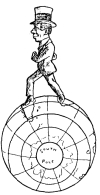
A GLOBE TROTTER.
138. Everyone knows that in a race on a circular track the competitor who has the “inside” running has the least ground to cover, hence the great desire of cyclists, jockeys, &c., to “hug the fence.”
Now a gentleman, six feet high, starts walking round the Earth on the equator; his feet, therefore, have the inside running. Find out how much further his head travels than his feet in performing this wonderful journey? taking the circumference of the globe at the equator to be 25,000 miles.
Precocious Juvenile—“Mamma, it isn’t good grammar to say ‘after I,’ is it?”
His Mother—“No, Georgie.”
Precocious Juvenile—“Well, the letter J comes after I. Which is wrong—the grammar or the alphabet?”
139. There is an island in the form of a semi-circle; two persons start from a point in the diameter; one walks along the diameter, and the other at right angles to it; the former reaches the extremity of the diameter after walking 4 miles, and the latter the boundary of the island after walking 8 miles. Find the area of the island.
140. There is a certain number consisting of three figures which is equal to 36 times the sum of its digits, and 7 times the left-hand digit plus 9, equal to 5 times the sum of the remaining digits, and 8 times the second digit minus 9 is equal to the sum of the first and third. What is the number?
141. A bottle and cork costs 2½d.; the bottle costs 2d. more than the cork. What is the price of each? [Pg 65]
A Cure for Big Words.
Here is a good story of how a father cured his son of verbal grandiloquence. The boy wrote from college, using such large words that the father replied with the following letter:—“In promulgating your esoteric cogitations, or articulating superficial sentimentalities, and philosophical or pscyhological observations, beware of platitudinous ponderosity. Let your conversation possess a clarified conciseness, compacted comprehensibleness, coalescent consistency, and a concatenated cogency. Eschew all conglomerations of flatulent garrulity, jejune babblement, and asinine affectations. Let your extemporaneous descantings and unpremeditated expatiations have intelligibility, without rhodomontade or thrasonical bombast. Sedulously avoid all polysyllabical profundity, pompous prolixity, and ventriloquial vapidity. Shun double entendre and prurient jocosity, whether obscure or apparent. In other words, speak truthfully, naturally, clearly, purely, but do not use big words.”
142. With a pair each of four different weights, 1 lb. up to 170 lbs. can be weighed. What are the weights?
143. A man going “on the spree” spends on the first day 10s. 5d., the second 18s., the third £1 8s. 7d., the fourth £2 2s. 8d., and so on at that rate of increase until he has spent all he had—£183 6s. 8d. How many days was he on the spree?
144. Divide one shilling into two parts, so that one will be 2½d. more than the other.
COMPLIMENTARY, VERY!
Editor—“Did you see the notice I gave you yesterday?”
Shopkeeper—“Yes, and I don’t want another. The man who says I’ve got plenty of grit, and that the milk I sell is of the first water, and that my butter is the strongest in the market, may mean well, but he is not the man whose encomiums I value.”
145. A vintner draws a certain quantity of wine out of a full vessel that holds 256 gallons, and then filling the same vessel with water draws off the same quantity of liquor as before, and so on for four draughts, when only 81 gallons of pure wine is left. How much wine did he draw each time?
146. A man has 4 horses, for which he gave £80; the first horse cost as much as the second and half of the third, the second cost as much as the fourth minus the cost of the third, the third cost one-third of the first, and the fourth cost as much as the second and third together. What was the price of each horse? [Pg 66]
The Divided Pound.
147. A father wishes to divide £1 between his four sons, giving one-third to one, one-fourth to another, one-fifth to another, and one-sixth to another; in doing so he finds he has only disbursed 19s.; the balance, 1s., is then divided in the same proportion. What amount does each receive in full in the proportion named?
RAILWAY-SHUNTING PUZZLE.
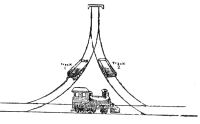
148. A locomotive is on the main line of railway; the trucks marked 1 and 2 are on sidings which meet at the points, where there is room for one truck only and not for the locomotive. It is desired to reverse the position of the trucks—that is, put 1 where 2 is, and 2 where 1 is, and yet leave the locomotive free on the main line. This must be done by means of the locomotive only, either pulling or pushing the trucks—it may be between them, thus pulling one and pushing the other—but no truck must move without the locomotive.
In working this puzzle out, it would be best to draw the diagram on an enlarged scale, and have articles to represent the trucks and locomotive.
149. In a public square there is a fountain containing a quantity of water; around it stand a group of people with pitchers and buckets. They draw water at the following rate: The first draws 100 quarts and one-thirteenth of the remainder, the second 200 quarts and one-thirteenth of the remainder, the third 300 quarts and one-thirteenth, and so on, until the fountain was emptied. How many quarts were there in the fountain?
ENGLISH FROM A GERMAN MASTER.
Prof. Goldburgmann—“Herr Kannstnicht, you will the declensions give in the sentence, “I have a gold mine.”
Herr Kannstnicht—“I have a gold mine; thou hast a gold thine; he has a gold his; we, you, they have a gold ours, yours, or theirs, as the case may be.”
Prof. Goldburgmann—“You right are; up head proceed. Should I what a time pleasant have if all Herr Kannstnicht like were!” [Pg 67]
SPENDING THEIR “ALL.”
150. Three men going “on the spree” decide to spend all their money. The first, A, “shouts” for the company and then gives his balance to B, who also in turn pays for 3 drinks and gives his balance to C, who can then just manage to pay for drinks once more at 6d. each. How much money had each?
151. There is a regiment of 7300 soldiers, which is to be divided into 4 companies—half of the first company, two-thirds of the second, three-quarters of the third, and four-fifths of the fourth—to be composed of the same number of men. How many soldiers are there in each company?
A GRAVE MISTAKE.
A Scotch tradesman, who had amassed, as he believed, £4000, was surprised at his old clerk’s showing by a balance-sheet his fortune to be £6000. “It canna be—count again,” said the old man. The clerk did count again, and again declared the balance to be £6000. Time after time he cast up the columns—it was still a 6, and not a 4, that rewarded his labours. So the old merchant, on the strength of his good fortune, modernised his house, and put money in the purse of the carpenter, the painter, and the upholsterer. Still, however, he had a lurking doubt of the existence of the extra £2000; so one winter’s night he sat down to give the columns “one count more.” At the close of his task he jumped up as though he had been galvanised, and rushed out in a shower of rain to the house of the clerk, who, capped and drowsy, put out his head from an attic window at the sound of the knocker, mumbling, “Who’s there, and what d’ye want?” “It’s me, ye scoundrel!” exclaimed his employer. “Ye’ve added up the year of our Lord amang the poons!”
PROBLEM FOR PRINTERS.
152. A book is printed in such a manner that each page contains a certain number of lines, and each line a certain number of letters. If each page contains 3 lines more, and each line 4 letters more, the number of letters in each page will be 224 more than before; but if each page contains 2 lines less, and each line 3 letters less, the number of letters in each page would be 145 less than before. Find the number of lines in each page, and the number of letters in each line.
THE INCOME TAX.
153. The charge on a major income is the same in amount as that on a minor one, which is 2½ per cent. of their mutual difference, but the rate imposed on the overplus of a major income is 4 per cent., so that on a composite income of the major and minor the charge would be £3 8s. Required the major and minor incomes. [Pg 68]
“Your Money or Your Life!”
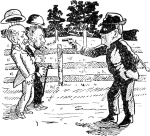
154. Two gentlemen, A and B, with £100 and £48 respectively, having to perform a long journey through a lonely part of the country, agree to travel together for purposes of safety; they are, however, taken unawares by a gang of bushrangers who, calling upon them to “bail up,” ease them of some of their cash. The leader of the gang was satisfied with taking twice as much from A as from B, and left to A three times as much as to B. How much was taken from each?
GEOMETRICAL MUSIC.
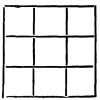
155. In this figure rub out eight lines, and
leave two squares. No side nor angle of any square must be left, otherwise that will
be counted as a square.
156. A and B travelled by the same road, and at the same rate from Tamworth to Sydney. A overtook a flock of sheep, which travelled at the rate of three miles in two hours, and two hours after he met a mail coach, which travelled at the rate of nine miles in four hours. B overtook the flock 45 miles from Sydney, and met the coach 40 minutes before he came to the 31-mile post from the Metropolis. Where was B when A reached Sydney? [Pg 69]
ENGLISH HISTORY.
A school examination paper contained the question:—“Write down all you know about Henry VIII,” and one of the small boys answered as follows:—
“King Henry 8 was the greatest widower that ever lived. He was born at Anne Domini in the year 1066. He had 510 wives besides children. The first was beheaded and afterwards executed, and the second was revoked. She never smiled again. But she said the word ‘Calais’ would be found on her heart after death. The greatest man in this reign was Lord Sir Garret Wolsey—named the Boy Bachelor. He was born at the age of fifteen unmarried. Henry 8 was succeeded on the throne by his great-grandmother, the beautiful Mary, Queen of Scots, sometimes called Lady of the Lake or the Lay of the Last Minstrel.”
157. Two boys, A and B, run round a ring in opposite directions till they meet at the starting point, their last meeting place before this having been 990 yards from it. If A’s rate to B’s be as 5 to 3, find the distance they have travelled.
THE VALUE OF HOME LESSONS.
Two teachers of languages were discussing matters and things relative to their profession.
“Do your pupils pay up regularly on the first of each month?” asked one of them.
“No, they do not,” was the reply; “I often have to wait weeks and weeks before I get my pay, and sometimes I don’t get it at all. You can’t well dun the parents for the money.”
“Why don’t you do as I do? I always get my money regularly.”
“How do you manage it?”
“It is very simple. For instance, I am teaching a boy French, and on the first day of the month his folks don’t send the amount due for the previous month. In that case I give the boy the following exercise to translate and write out at home:—‘I have no money. The month is up. Hast thou any money? Have not thy parents any money? I need money very much. Why hast thou brought no money this morning? Did thy father not give thee any money? Has he no money in the pocket-book of his uncle’s great aunt?’ This fetches them. Next morning that boy brings the money.”
158. There is a number half of which divided by 6, one-third of it divided by 4, and one-fourth of it divided by 3, each quotient will be 9. What is the number?
QUIBBLE.
SOMETHING EASY.
160. Find a sum of £ s. d. (no farthings) in which the figures, in their order, represent the amount reduced to farthings.
161. Three persons won a “consultation” worth £1,320. If J were to take £6, M ought to take £4, and B £2. What is each person’s share?
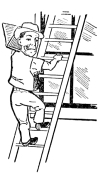
“ON THE JOB.”
162. Six masons, four bricklayers and five labourers were working together at a building, but being obliged to leave off one day by the rain, they went to a public-house and drank to the value of 45s., which was paid by each party in the following manner: Four-fifths of what the bricklayers paid was equal to three-fifths of what the masons paid, and the labourers paid two-sevenths of what the masons and bricklayers paid. What did each party of men pay?
163. In a certain speculation I gained £4 19s. 11¾d. for each pound I expended, and by a curious coincidence I found that £4 19s. 11¾d. was the exact amount I had ventured. Required the amount of capital and profit together.
HIS MAJORITY.
164. “I am not a man, I suppose, till I am 21. How long have I to wait yet, if the cube root of my age eight years hence, added to the cube root of my age eleven years ago would make 5?”
DRAUGHT-BOARD PUZZLE.
165. Place eight men on a draught-board in such a way that no two will be in a line either crossways or diagonally. Of course the two colours on the board must be used.
166. A gentleman, dying, left his property thus: To his wife, three-fifths of his son’s and youngest daughter’s shares; to his son, four-fifths of his wife’s and eldest daughter’s shares; to his eldest daughter, two-sevenths of his wife’s and son’s shares, and to his youngest daughter one-sixth of his son’s and eldest daughter’s shares. The wife’s share was £4,650. What did the gentleman leave, and what did each receive?
SAMSON OUTDONE.
A man boasted that he carried off an entire timber yard in his left hand. It turned out that the timber-yard was a three-foot rule. [Pg 71]
Domino Puzzle.

167. Arrange the 28 dominoes in such a manner as to have two squares of each number; there are eight half-squares of each number in the complete set—eight sixes, eight fives, &c.—so that four of the one number comprise a square. The whole, when finished, will form a figure like a square, resembling a wide letter I.

168. A sum of money is divided among a number of persons; the second gets 8d. more than the first, the third gets 1s. 4d. more than the second, the fourth 2s. more than the third, and so on. If the first gets 6d. and the last £5 2s. 6d., how many persons were there?
IT COULDN’T BE EXPECTED.
Teacher: “Johnny, where is the North Pole?”
Johnny: “I don’t know.”
Teacher: “Don’t know where the North Pole is?”
Johnny: “When Franklin, Nansen and Captain Andrée hunted for it and couldn’t find it, how am I to know where it is?”
169. For a loan of 2,500,000, 4½ per cent. per annum is paid by a mining company whose capital is £4,900,000. The working expenses constitute 52 per cent. of the gross receipts, which amount in the year to £965,000, and the directors set apart £44,450 as a reserve fund. What yearly dividend do the shareholders receive?
170. If a monkey climbs a greasy pole 10 ft. high, ascending 1 ft. with each movement of his arms, and slipping back 6 in. after each advance; how many movements would he have to make, to touch the top, and what height would he have climbed in all?
171. Find two numbers whose G.C.M. is 179, L.C.M. 56385, and difference 10382.
172. What is the difference between twenty four-quart bottles, and four and twenty quart bottles?
THE G.C.M.
The Greatest Common Measure—A “long pint.” [Pg 72]
173. There are two casks, one of which holds thirty gallons more than the other. The larger is filled with wine, the smaller with water. Ten gallons are taken out of each: that from the first is poured into the second; the operation is repeated, and it is now found that the larger cask contains 13 gallons of water. Find the contents of each cask.
175. If three first-class cost as much as five second-class tickets for a journey of 100 miles, the total cost of the eight tickets being £3 2s. 6d., find the charge per mile for each first-class and second-class ticket.
HUMILITY.
In a certain street are three tailors. The first to set up shop hung out this sign—“Here is the best tailor in the town.” The next put up—“Here is the best tailor in the world.” The third simply had this—“Here is the best tailor in this street.”
“On the Wallaby.”
176. Four sundowners called at a station and asked for rations. “Well,” said the manager, “I have a job that will take 200 hours to complete; if you want to do it, you can divide the work and the money among yourselves as you see fit.” The sundowners agreed to do the work on these conditions. “Now, mates,” said the laziest of them, “it’s no good all of us doing the same amount of work. Let’s toss up to see who shall work the most hours a day, and who the fewest. Then let each man work as many days as he does hours a day.” This was agreed to; but the proposer took good care that chance should designate him to do the least number of hours of work. How were the 200 hours put in so that each man should work as many hours as days, and yet no two men work the same number of hours?
177. On multiplying a certain number by 517 a result is obtained greater by 7,303,535 than if the same number had been multiplied by 312. How much greater still would be the result if 811 were the multiplier instead of 312?
A “CATCH.”
178. Six ears of corn are in a hollow stump. How long will it take a squirrel to carry them all out if he takes but three ears a day? [Pg 73]
NUMBER 7.
The number 7 has always been considered the most sacred of all our figures. Its prominence in the Scriptures is very remarkable, from Genesis—where we read that the seventh day was consecrated as a day of rest and repose—to Revelations—where we find the seven churches of Asia; seven golden candlesticks; the book with seven seals; the seven angels with seven trumpets; seven kings; seven thunders; seven plagues, &c., &c., its frequent occurrence is most striking.
The Ancients paid great respect to the seven mouths of the Nile. The seven rivers of Vedic India; seven wonders of the world; seven precious stones; seven notes of music; seven colours of the rainbow, &c., &c. The “Lampads seven that watch the Throne of Heaven” led the Chaldeans to esteem the unit 7 as the holiest of all numbers, thereupon they established the week of seven days, and built their temples in seven stages. The temples and palaces of Burma and China are seven-roofed.
In modern times this number has kept up its reputation. Shakespeare paid special regard to it; the “seven ages” and every multiple of it is supposed to be a critical or important period in one’s life.
A modern philosopher as follows apportions—
Man’s Full Extreme.
| 7 years in childhood, sport and play, | (7) |
| 7 years in school from day to day, | (14) |
| 7 years at trade or college life, | (21) |
| 7 years to find a place and wife, | (28) |
| 7 years to pleasure’s follies given, | (35) |
| 7 years to business hardly driven, | (42) |
| 7 years for some wild-goose chase, | (49) |
| 7 years for wealth, a bootless race, | (56) |
| 7 years of hoarding for your heir, | (63) |
| 7 years in weakness spent and care, | (70) |
| And then you die and go—you know not | where. |
Very many superstitious and curious ideas have been and still are connected with all our figures. For those interested in this subject see page 146—“How To Become Quick At Figures” (Student’s Edition).
“What’s the difference,” asked a teacher in arithmetic, “between one yard and two yards?” “A fence,” said Tommy Yates. Then Tommy sat on the ruler 14 times.
179. What relation is a woman to me who is my mother’s only child’s wife’s daughter? [Pg 74]
THE ADVANTAGES OF SKILFUL BOOK-KEEPING.
If a merchant wishes to get pretty deeply in debt, and then get rid of his liabilities by bankruptcy—if, in fact, he proposes to himself to go systematically into the swindling business, and engage in wholesale pecuniary transactions without a shilling of his own, the first thing he should take care to learn would be the whole art of book-keeping.
From what may occasionally be seen of the reports of the proceedings in bankruptcy, it is found that well kept books are regarded as quite a test of honesty, and though assets may have disappeared or never have existed, though large liabilities may have been incurred without any prospect of payment, the bankrupt will be complimented on the straight look of his dealings, if he has shown himself a good book-keeper.
To common apprehension it would seem that well kept books would only help to show a reckless trader the ruinous result of his proceedings, and that while the man without books might flatter himself that all would come out right at last, the man with exact accounts would only get into hot water with his eyes open. If a man may trade on the capital of others without any of his own, and get excused on the ground that he has kept his books correctly, it is difficult to see why a thief who steals purses, &c., may not plead in mitigation of punishment that he has carefully booked the whole of his transactions.
It would be interesting to know the effect of producing a ledger on a trial for felony, as well as curious to observe whether a burglar would be leniently dealt with on the ground that his house-breaking accounts gave proof of his experience in the science of “double-entry.”
Therefore it would be well for those interested to procure copies of “Re Accounts” and “Advanced Thought on Accounts.”
THE FIRM HE REPRESENTED.
A commercial traveller handed a merchant upon whom he had called a portrait of his sweetheart in mistake for his business card, saying that he represented that establishment. The merchant examined it carefully, remarked that it was a fine establishment, and returned it to the astonished and blushing traveller with the hope that he would soon be admitted into partnership.
180. A man and a boy being paid for certain days’ work, the man received 27s., and the boy, who had been absent 3 days out of the time, received 12s. Had the man, instead of the boy, been absent the 3 days they would both have claimed an equal sum. Find out the wages of each per day.
181. The extremes of an arithmetical series are 21 and 497, and the number of terms is 41. What is the common difference? [Pg 75]
182. A wine which contains 7½ per cent. of spirit is frozen, and the ice which contains no spirit being removed the proportion of spirit in the wine is increased by 8¾ per cent. How much water in the shape of ice was removed from 504 gallons of the mixture?
THE SHARP SELECTOR.
183. A selector rented a farm, and agreed to give his landlord two-fifths of the produce, but prior to the time of dividing the corn the selector used 45 bushels. When the general division was made it was proposed to give to the landlord 18 bushels from the heap in lieu of the share of the 45 bushels which the tenant had used, and then to begin and divide the remainder as though none had been used. Would this method have been correct?
A GOOD “AD.”
A member of a certain firm appeared in a law court with a complaint that his partner would sell goods at less than cost price, and he desired to have him restrained. The defendant utterly denied the charge, and the case was adjourned for a fortnight. As the plaintiff went out of court he exclaimed in a tragic tone: “Then the sacrifice must still go on!” and “I’ll be ruined!” The story was noised abroad, and the result was that the shop was besieged by customers every day. There the case ended, for at the end of the fortnight the plaintiff failed to appear in court, having accomplished his purpose—advertisement.
184. I give 3 sovereigns for 2 dozen wine at different rates per dozen, and by selling the cheaper kind at a profit of 15 per cent. and the dearer at a loss of 8 per cent. I obtain a uniform price for both. What did each dozen cost me?
185. I have in my garden a shrub that grows 12 inches every day, but during the night it withers off to half the height that it was at the end of the previous day. How much short of 2 feet will it be at the end of a year?
TIT-FOR-TAT.
186. A farmer puts a 3 lb. stone in a keg of butter worth 11d. a pound. The merchant cheats him out of 1 lb. on the weight, and then does him out of 1s. 11d. on calico, tobacco, and a shovel. Who is ahead, and how much?
187. Trains leave London and Edinburgh (400 miles apart) at the same time and meet after 5 hours; the train which leaves London travels 8 miles an hour faster than that which leaves Edinburgh. At what rate did the former travel, and at what speed must the latter travel after they have met, in order that they both may reach their destinations at the same time? [Pg 76]
“GOOD ENOUGH!”
“Will you give me a glass of beer, please?” asked a rather seedy-looking fellow with an old but well-brushed coat and almost too shiny a hat. It was produced by the barmaid, frothing over the edge of the tumbler.
“Thank you,” said the recipient, as he placed it to his lips. Having finished it in a swallow, he smacked his lips and said, “That is very good beer—very! Whose is it?”
“Why, that Perkins’s——”
“Ah! Perkins’s, is it! Well, give us another glass.”
It was done; and holding it up to the light and looking through it, the connoisseur said:—
“’Pon my word, it is grand beer—clear as Madeira! What a fine color! I must have some more of that; give me another glass.”
The glass was filled again, but before putting it to his lips the imbiber said:—
“Whose beer did you say this was?”
“Perkins’s,” emphatically replied the barmaid.
The contents of the glass was exhausted, as also the vocabulary of praise, and it only remained for the appreciative gentleman to say, as he wiped his mouth and went towards the door:—
“Perkins’s beer, is it! I know Perkins very well; I shall see him soon, and will settle with him for three long glasses of his incomparable brew. Good morning.”
A Conspiracy.
188. Three gentlemen are going over a ferry with their three servants, who conspire to rob them if they can get one gentleman to two of them, or two to three, on either side of the ferry. They have a boat that will only carry two at once, and either a gentleman or a servant must bring back the boat each time a cargo of them goes over. How can the gentlemen get over with all their servants so as to avoid an attack?
189. Find two numbers whose product is equal to the difference of their squares, and the sum of their squares equal to the difference of their cubes?
190. Divide 1400 into such parts as shall have the same ratio as the cubes of the first four natural numbers.
This was the tempting notice lately exhibited in the window of a dealer in cheap shirts: “They won’t last long at this price!” [Pg 77]
POSTING THE LEDGER.
The well known author of several works on account-keeping, Mr. Yaldwyn, tells a rather good thing which actually occurred in New Zealand some time back. Mr. Yaldwyn was at the time engaged examining the books in one of the offices in a country town, and enquired from one of the clerks standing near if the ledger were posted. The person appealed to answered that “he didn’t know,” whereupon Mr. Y. said that he required it done, and with as little delay as possible. A few minutes later the same individual came rushing in and informed him that the ledger was “posted.” Such a piece of “lightning book-keeping” so surprised Mr. Y. that he further questioned the man, who replied “You said you wanted the ledger posted, and, begorra, I posted it.” It then dawned upon Mr. Yaldwyn that the clerk, who was an Irishman, had actually posted the book in the post office!
THEY MANAGED IT.
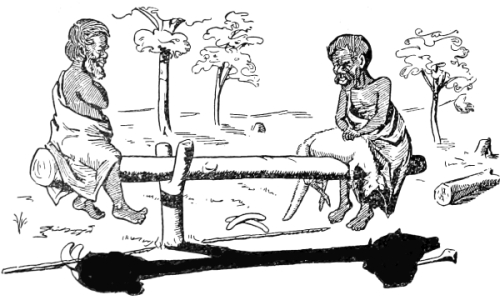
191. Billy and Tommy, two aboriginals, killed a kangaroo in the bush, and began quarrelling over the weight of the animal. They had no proper means of weighing it, but, knowing their own weights, Billy 130 lbs. and Tommy 190 lbs., they placed a log of wood across a stump so that it balanced with one on each end. They then exchanged places, and, the lighter man taking the kangaroo on his knees, the log again balanced. What was the weight of the kangaroo?
192. A son asked his father how old he was, and received the following answer: “Your age is now one quarter of mine, but five years ago it was only one-fifth.” How old is the father?
193. Place three sixes together so as to make seven. [Pg 78]
THE PASSING TRAINS PUZZLE.
194. If through passenger trains running to and from New York and San Francisco daily start at the same hour from each place (difference of longitude not being considered) and take the same time—seven days—for the trip, how many such trains coming in an opposite direction will a train leaving New York meet before it arrives at San Francisco?
THE SCHOOL-TEACHER “CAUGHT.”
Two of our Public Schools were engaged playing a football match one afternoon. The head master of one of them had generously given the boys a half-holiday; but the gentleman who held the same capacity in the other school, not being an ardent admirer of Australia’s national game, refused to do so. When school assembled in the afternoon, a boy volunteered to ask the master for the desired holiday. When the question was put, he firmly answered, “No, no!” whereupon the bright youth called out: “Hurrah! we have our holiday; two negatives make an affirmative.” The teacher was so pleased at the boy’s sharpness that he dismissed the school right away.
195. A man arrives at the railway station nearest to his home 1½ hours before the time at which he had ordered his carriage to meet him. He sets out at once to walk at the rate of four miles an hour, and, meeting his carriage when it had travelled eight miles, reaches home exactly one hour earlier than he had originally expected. How far was his house from the station, and at what rate was his carriage driven?
“OFF THE TRACK.”
196. A man starts to walk from a town, A, to a town B, a distance by road of 16 miles, at the rate of 4 miles an hour. There is a point C on the road, at which the road to B leads away to the right, and another road at right-angles to this latter goes to the left, “to no place in particular.” The unwary traveller gets on to this left hand road, and is walking for 2¼ hours since he left A, before he finds out his mistake, and he resolves not to go back to the junction, which is five miles away, but makes straight across the bush to B, and strikes it exactly. How long did it take to go from A to B?
GAMBLING.
197. Three friends, A, B, and C, sit down to play cards. As a result of the first game, A lost to each of B and C as much money as they started to play with; the result of the second game B lost similarly to each of A and C; and in the third, C lost similarly to each of A and B;—and they then had 24s. each. What had they each at first? [Pg 79]
This Sticks Them Up.
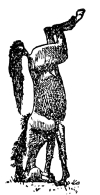
198. A, who is a dealer in horses, sells one to B
for £55. B very soon discovers that he does not require the animal, and sells him
back to A for £50. Now, A is not long in finding another customer for
the horse: he sells it to C for £60. How much money does A make out
of this transaction?
This question has been the cause of endless discussion and argument.
It might be as well to state that when A first sold the horse to B he neither made nor lost any money by the deal.
SCRIPTURAL FINANCE.
199. What is the earliest banking transaction mentioned in the Bible? The answer generally given to this is, “The check which Pharaoh received on the banks of the Red Sea, crossed by Moses & Co.” There is still an earlier instance: see if you can find it out.
200. How much tea at 6s. per lb. must be mixed with 12 lbs. at 3s. 8d. per lb. so that the mixture may be worth 4s. 4d. per lb.?

201. Place 17 little sticks—matches, for instance—making six equal squares, as in the margin, then remove five sticks and leave three perfect squares of the same size.
FOR THE JEWELLER.
202. How much gold of 21 and 23 carats must be mixed with 30 oz of 20 carats, so that the mixture may be 22 carats?
LONDON GRAMMAR.
Three cockneys, being out one evening in a dense fog, came up to a building that they thus described. The first said, “There’s a nouse.” “No,” said the second, “It’s a nut.” The third exclaimed “You’re both wrong; it’s a nin!”
203. A draper sold 12 yards of cloth at 20s. per yard, and lost 10 per cent. What was the prime cost?
204. A jockey, on a horse galloping at the rate of 18 miles an hour on the Flemington racecourse, passes in 30 minutes over the diameter and curve of a semi-circle. What area does he enclose by the ride?
205. How many trees 20 feet apart cover an acre? [Pg 80]
MULTIPLY £19 19s. 11¾d. BY £19 19s. 11¾d.
This very old question is continually cropping up, and will continue to do so as long as men are able to reckon. The answer generally given is £399 19s. 2d. and a fraction, and the method of working it out as follows:—
£19 19s. 11¾d. = 19199 farthings.
| 19199 | x | 19199 | = | 368601601 | and so on. |
| 960 | 960 | 921600 |
Many adopt the following method:—
£20 x £20 = £400
| ¼d x ¼d = 1⁄16 | less | £ s d | Ans. |
| £400 0 0 | |||
| 1⁄16 | |||
| £399 19 11 15⁄16 |
It would be possible to adopt other methods, each of which would give a different result.
Properly speaking, this sum cannot be done.
Multiplication is merely a contracted form of addition: it means taking a number or quantity a certain number of times. Every multiplication can be proved by addition. All numbers are abstract or concrete—3 is abstract, £3 is concrete.
Two abstract numbers can be multiplied together—as, 4 times 3 = 12.
One abstract number and one concrete number can be multiplied together—as 2s. multiplied by 3 = 6s.
Two concrete numbers cannot be multiplied together. [Pg 81]
In the example just given, 2s. multiplied by 3, we see it simply means to write down 2s. three times, and by addition we discover the answer to be 6s. Suppose the reader lent a friend 2s. on Monday, 2s. on Tuesday, and 2s. on Wednesday, he has lent 2s. three times, making 6s. lent in all.
Now, we will attempt to multiply 2s. by 3s., but it is impossible to comprehend how many times is 3s. times. The answer to 2s. x 3s. usually given is 6s. On the same lines, we multiply 9d. by 10d., and our answer is—90d., that is 7s. 6d.—a greater product than 2s. multiplied by 3s.
Although it is stated that two concrete numbers cannot be multiplied together, it should be borne in mind that we can multiply yards, feet, and inches, by yards, feet, and inches (length by breadth), which will result in square or cubic measure: 12 inches make 1 foot, and 3 feet make one yard, 144 square inches make 1 square foot, &c. 12 pence make 1 shilling, but how many square pence make 1 square shilling?
The argument generally brought forward in favour of the performance of this problem is, that when the Rule of Three is applied to financial questions (such as interests, &c.) money is multiplied by money.
Example.—If the interest on £10 is 15s., what is the interest on £20?
As £10 : £20 :: 15s. : x
| 10 | 15 | Ans. 30s. |
| )300 | ||
| 30 |
The multiplication in the above is in appearance only, for all we get in the Rule of Three is the ratio between the sums of money and this ratio is an abstract number, and not concrete. On examination we find the ratio between £10 and £20; that the latter is double, or two times as much as the former, and not £2 times more than it.
We extend a general invitation to all our readers who hold a different opinion to multiply three pints of Dewar’s Whisky by 6 quarts of soda-water, but in case they might plead inability to perform this little feat, on conscientious grounds, we will extend the invitation to three cups of tea by six spoonfuls of sugar. And if any of them have a few pounds (say £10) in the Savings Bank we would advise “Don’t add any more deposits, but wait till you have £2, then proceed to the bank and multiply the £10 by the £2, and prove to the teller that you have £20 to your account. Be careful to take no less a sum than £2, or the result might be a little surprising, for if you take only £1, the teller might argue after he has received your sovereign that “ten ones are ten,” and then your £10 would remain the same.”
206. What is the difference between six dozen dozen and half a dozen dozen? [Pg 82]
A TELL-TALE TABLE.
There is a good deal of amusement in the following table. It will enable you to tell how old the young ladies are. Ask a young lady to tell you in which column or columns her age is found, add together the figures at the top of the columns in which she says her age is, and you have the secret. Suppose a young lady is 19. You will find that number in the first, second and fifth columns; add the first figures of these columns—1, 2 and 16—and you get the age.
| 1 | 2 | 4 | 8 | 16 | 32 |
| 3 | 3 | 5 | 9 | 17 | 33 |
| 5 | 6 | 6 | 10 | 18 | 34 |
| 7 | 7 | 7 | 11 | 19 | 35 |
| 9 | 10 | 12 | 12 | 20 | 36 |
| 11 | 11 | 13 | 13 | 21 | 37 |
| 13 | 14 | 14 | 14 | 22 | 38 |
| 15 | 15 | 15 | 15 | 23 | 39 |
| 17 | 18 | 20 | 24 | 24 | 40 |
| 19 | 19 | 21 | 25 | 25 | 41 |
| 21 | 22 | 22 | 26 | 26 | 42 |
| 23 | 23 | 23 | 27 | 27 | 43 |
| 25 | 26 | 28 | 28 | 28 | 44 |
| 27 | 27 | 29 | 29 | 29 | 45 |
| 29 | 30 | 30 | 30 | 30 | 46 |
| 31 | 31 | 31 | 31 | 31 | 47 |
| 33 | 34 | 36 | 40 | 48 | 48 |
| 35 | 35 | 37 | 41 | 49 | 49 |
| 37 | 38 | 38 | 42 | 50 | 50 |
| 39 | 39 | 39 | 43 | 51 | 51 |
| 41 | 42 | 44 | 44 | 52 | 52 |
| 43 | 43 | 45 | 45 | 53 | 53 |
| 45 | 46 | 46 | 46 | 54 | 54 |
| 47 | 47 | 47 | 47 | 55 | 55 |
| 49 | 50 | 52 | 56 | 56 | 56 |
| 51 | 51 | 53 | 57 | 57 | 57 |
| 53 | 54 | 54 | 58 | 58 | 58 |
| 55 | 55 | 55 | 59 | 59 | 59 |
| 57 | 58 | 60 | 60 | 60 | 60 |
| 59 | 59 | 61 | 61 | 61 | 61 |
| 61 | 62 | 62 | 62 | 62 | 62 |
| 63 | 63 | 63 | 63 | 63 | 63 |
COIN PUZZLE.

207. Place four florins alternately with four pennies, and in four moves, moving two adjacent coins each time, bring the florins together and the pence together. When finished there must be no spaces between the coins.
208. If 2 be added to the numerator of a certain fraction, it is made equal to one-fifth, whilst if 2 be taken from the denominator it becomes equal to one-sixth. Find the fraction. [Pg 83]
EUCLID.—The Famous Forty-Seventh.
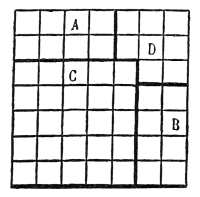
Fig. 1.
“In any right-angled triangle, the square which is described upon the side opposite to the right-angle is equal to the squares described upon the sides which contain the right-angle.”
Here is a simple way of proving this proposition. Although perhaps not exactly scholastic, it is none the less interesting.
Draw an exact square, whose sides measure 7 in.; then divide it into 49 square inches. Having done this, cut the figure in following the big lines as shown by Fig 1. It will be observed that C is a complete square, and that A and B will form a square: but as D is 1 in. short of being a square, it is necessary to cut a square inch and add it on.
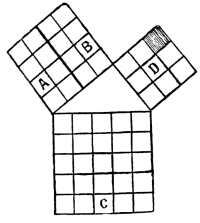
Fig. 2.
Then construct a right-angled triangle as shown by Figure 2.
We then see that the sum of the two small squares is equivalent to the large square.
And as we see that C has 25 small squares, it is thus proved that the sum of the squares upon the sides which contain the right angle are equal to the squares upon the side opposite the right angle.
Q.E.D.
THE GREAT FISH PROBLEM.
209. There is a fish the head of which is 9 in. long, the tail is as long as the head and half the back, and the back is as long as the head and tail together. What is the length of the fish?
210. How may 100 be expressed with four nines?
211. Two shepherds, A and B, meeting on the road, began talking of the number of sheep each had, when A said to B, “Give me one of your sheep, and I will have as many as you.” “Oh, no!” replied B; “give me one of yours, and I will have as many again as you.” How many sheep had each? [Pg 84]
A BRICK PUZZLE.
One for Builders, Contractors, &c.
212. Suppose the measurements of a brick to be:—Length, 9 in.; breadth, 4½ in.; depth, 3 in. How many “stretchers, headers and closures” can be cut out of one, and what would be the face area of same?
For the benefit of the uninitiated we might say that
“stretcher” = length of brick x depth
“header” = breadth "
“closure” = half-breadth "
213. A woman has a basket of 150 eggs; for every 1½ goose egg she has 2½ duck eggs and 3½ hen eggs. How many of each had she?
The Great Chess Problem.

THE KNIGHT MOVE.
214. Move the Knight over all the 64 squares of the chess board so as to successively cover each square and, of course, not enter any square twice. This problem has always proved to be an interesting one. Mathematicians throughout all ages have devoted a good deal of time to it. To chess players it should be especially attractive.
215. If 3 times a certain number be taken from 7 times the same number the remainder will be 8. What is the number?
216. Divide £27 among 3 persons, A, B and C, so that B may have twice as much as A, and C 3 times as much as B.
ANSWER THIS.
217. Suppose it were possible for a man in Sydney to start on Sunday noon, January 1st, and travel westward with the sun, so that it might be in his meridian all the time, he would arrive at Sydney next day at noon, Monday, Jan. 2nd. Now, it was Sunday noon when he started, it was noon with him all the way round, and is Monday noon when he returns. The question is, at what point did it change from Sunday to Monday?
218. Start with 1 and keep on doubling for eight times, thus giving nine numbers, and arrange them in a square that when multiplied together, horizontally, vertically, or diagonally, the product of each row will be the cube of the number which must go in the centre of the square.
The happiest year in a man’s life is 40; for then he can XL. [Pg 85]
Bound to Win!
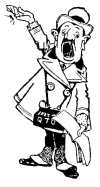
219. A certain gentleman, who was employed in one of our city offices, purchased The Doctrine of Chance, which he studied in his spare time, with the result that he sent in his resignation to the head of the firm in order to try his luck on the racecourse.
At the first meeting he attended, there were only three horses in a race. His brother bookmakers were crying out the odds—
“Two to 1 bar one.”
The odds on this latter horse which was “barred” he discovered to be 6 to 4 on. He determined to give far more liberal odds, and called out—
“Even money, 2 to 1, and 3 to 1.”
How could he give such odds, and yet win £1, no matter which horse wins the race?
AN INCH OF RAIN.
How many people really consider what is contained in the expression? Calculated, it amounts to this:—An acre is equal to 6,272,640 square inches; an inch deep of water on this area will be as many cubic inches of water, which, at 277·274 inches to the gallon, is 22622·5 gallons. The quantity weighs 226,225 lbs. Thus, an “inch of rain” is over 100 tons of water to the acre.
Extract from a small boy’s first essay:—“Man has two hans. One is the rite han an one is the left han. The rite han is fur ritin, and the left han is fur leftin. Both hans at once is fur stummik ake.”
220. Find the side of a square whose area is equal to twice the sum of its sides?
“THE EVIDENCE YOU NOW GIVE, &c., &c.”
221. Smith, Brown, and Jones were witnesses in a law case. The first-named gentleman swore that a certain thing occurred; Brown, on being called, confirmed Smith’s statement, but Jones denied it. They are known to tell the truth as follows:—
What is the probability that the statement is true?
When a man attains the age of 90 years, he may be termed XC-dingly old. [Pg 86]
A school examination room might not to a casual observer seem to be a very likely place to find entertainment. However, the answers often given by pupils are sometimes excruciatingly funny, as is proved by the following:—
Definitions.
Function.—“When a fellow feels in a funk.”
Quotation.—“The answer to a division sum.”
Civil War.—“When each side gives way a little.”
The Four Seasons.—“Pepper, mustard, salt and vinegar.”
Alias.—“Means otherwise—he was tall, but she was alias.”
Compurgation.—“When he was going to have anything done to him, and if he could get anyone to say, ‘not innocent,’ he was let off.”
The Equator.—“Means the sun. Suppose we draw a straight line and the sun goes up to the top, then it is day, and when it comes down it is night.”
Precession.—“(1) When things happen before they take place. (2) The arrival of the equator in the plane of the ecliptic before it is due.”
Demagogue.—“A vessel that holds beer, wine, gin, whisky, or any other intoxicating liquor.”
Chimera.—“A thing used to take likenesses with.”
Watershed.—“A place in which boats are stored in winter.”
Gender.—“Is the way whereby we tell what sex a man is.”
Cynical.—“A cynical lump of sugar is one pointed at the top.”
Immaculate.—“State of those who have passed the entrance examination at the University.”
Frantic.—“Means wild. I picked up some frantic flowers.”
Nutritious.—“Something to eat that aint got no taste to it.”
Repugnant.—“One who repugs.”
Memory.—“The thing you forget with.”
History.
“Without the uses of History everything goes to the bottom. It is a most interesting study when you know something about it.”
“Oliver Cromwell was a man who was put into prison for his interference in Ireland. When he was in prison he wrote ‘The Pilgrim’s Progress,’ and married a lady called Mrs. O’Shea.”
“Wolsey was a famous General who fought in the Crimean war, and who, after being decapitated several times, said to Cromwell, ‘Ah, if I had only served you as you have served me, I would not have been deserted in my old age.’ He was the founder of the Wesleyan Chapel, and was afterwards called Lord Wellington. A monument was erected to him in Hyde Park, but it has been taken down lately.”
“Perkin Warbeck raised a rebellion in the reign of Henry VIII. He said he was the son of a Prince, but he was really the son of respectable people.” [Pg 87]
Which do you consider the greater General, Cæsar or Hannibal? “If we consider who Cæsar and Hannibal were, the age in which they lived, and the kind of men they commanded, and then ask ourselves which was the greater, we shall be obliged to reply in the affirmative.”
Why was it that his great discovery was not properly appreciated until after Columbus was dead? “Because he did not advertise.”
What were the slaves and servants of the King called in England? “Serfs, vassals, and vaselines.”
Divinity.
Parable.—“A heavenly story with no earthly meaning.”
“Esau was a man who wrote fables, and who sold the copyright to a publisher for a bottle of potash.”
What is Divine right? “The liberty to do what you like in church.”
What is a Papal bull? “A sort of cow, only larger, and does not give milk.”
“Titus was a Roman Emperor, supposed to have written the Epistle to the Hebrews. His other name was Oates.”
Explain the difference between the religious belief of the Jews and Samaritans? “The Jews believed in the synagogue, and had their Sunday on a Saturday; but the Samaritans believed in the Church of England and worshipped in groves of oak; therefore the Jews had no dealings with the Samaritans.”
Give two instances in the Bible where an animal spoke? “(1) Balaam’s ass. (2) When the whale said unto Jonah, ‘Almost thou persuadest me to be a Christian.’”
Mathematics.
A Problem.—“Something you can’t find out.”
Hypotenuse.—“A certain thing is given to you, or it means let it be granted that such and such a thing is equal or unequal to something else.”
“If there are no units in a number you have to fill it up with all zeros.”
“Units of any order are expressed by writing in the place of the order.”
“A factor is sometimes a faction.”
“If fractions have a common denominator, find the difference in the denominator.”
“Interest on interest is confound interest.”
Grammar.
“Grammar is the way you speak in 9 different parts of speech; it is an art divided in 4 quarters—tortology is one, and sintax one more.”
An Abstract Noun.—“Something you can think of, but not touch—a red-hot poker.”
An Article.—“That wich begins words and sentences.”
A Pronoun “is when you don’t want to say a noun, and so you say a pronoun.”
“A Adjective is the colour of a noun, a black dog is a adjective.”
“Adjectives of more than one syllable are repaired by adding some more syllables.”
“Nouns are the names of everything that is common and has a proper name.”
Verb.—“To go for a swim is a verb what you do.”
“Adverbs are verbs that end with a lie and distinguish words. It is used to mortify a noun, and is a person, place, or thing, sometimes it is turned into a noun and then becomes a noun or pronoun.”
“Preposition means when you say anything of anything.”
“Conjunction means what joins things together; ‘—and 2 men shook hands.’”
“Nouns denoting male and female and things without sex is neuter. ‘The cow jumped over the fence’ is a transitif nuter verb because fence isen’t the name of anything and has no sex.”
Interjection.—“Words which you use when you sing out.”
“Gender is how you tell what sex a man is.”
Which Hand is It In?
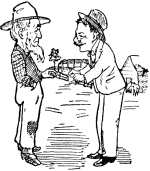
A person having in one hand a piece of gold, and in the other a piece of silver, you may tell in which hand he has the gold, and in which the silver, by the following method:—
Some even number (such as 8) must be given to the gold, and an odd number (such as 3) must be given to the silver; after which, tell the person to multiply the number in the right hand by any even number whatever, and that in the left hand by an odd number; then bid him add together the two products, and if the whole sum be odd, the gold will be in the right hand and the silver in the left; if the sum be even, the contrary will be the case.
To conceal the artifice better, it will be sufficient to ask whether the sum of the two products can be halved without a remainder—for in that case the total will be even, and in the contrary case odd.
222. Which is the heavier, and by how much—a pound of gold or a pound of feathers; an ounce of gold or an ounce of feathers?
223. Plant an orchard of 21 trees, so that there shall be 9 straight rows with 5 trees in each row, the outline to be a regular geometrical figure. [Pg 89]
SETTLING UP.
224. A person paid a debt of £5 with sovereigns and half-crowns. Now, there were half the number of sovereigns that there were half-crowns. How many were there of each?
A “CATCH.”
| | | | | | | | | | | | | | | | | | | |
225. How can you rub out 20 marks on a slate, have only five rubs, and rub out every time an odd one?
227. A man and his wife lived in wedlock, one-third of his age and one-fourth of hers. Now, the man was eight years older than his wife at marriage, and she survived him 20 years. How old were they when married?
TO PROVE THAT YOU HAVE ELEVEN FINGERS.
Count all the fingers of the two hands, then commence to count backwards on one hand, saying, “10, 9, 8, 7, 6” (with emphasis on the 6), and hold up the other hand saying, “and 5 makes 11.” This simple deception has often puzzled many.
228. A man travelled a certain journey at the rate of four miles an hour, and returned at the rate of three miles an hour. He took 21 hours in going and returning. What was the total distance gone over?
229. From what height above the earth will a person see one-third of its surface?
230. The difference between 17⁄21 and 11⁄14 of a certain sum is £10. What is the sum?
231. What decimal fraction is a second of a day?
232. Two trains are running on parallel lines in the same direction at rates respectively 45 miles and 35 miles an hour; the length of the first is 17 yds. 2 ft., and of the second 70 yds. 1 ft. How long will the one be in passing the other?
WORTH TRYING.
A well known writer on mathematics, and a member of the Academy of Science, Paris, says that the most skilful calculator could not in less than a month find within a unit the cube root of 696536483318640035073641037.
A PROBLEM THAT WORRIED THE ANCIENTS.
Many profound works have been written on the following famous problem:—
“When a man says ‘I lie,’ does he lie, or does he not? If he lies he speaks the truth; if he speaks the truth he lies.”
Several philosophers studied themselves to death in vain attempts to solve it. Reader, have a “go” at it.
THE CABINET MAKER’S PUZZLE.
234. A cabinet maker has a circular piece of veneering with which he has to veneer the tops of two oval stools; but it so happens that the area of the stools, exclusive of the hand-holes in the centre and that of the circular piece, are the same. How must he cut his veneer so as to be exactly sufficient for his purpose?
THE ARITHMETICAL TRIANGLE.
| 1 | |||||||
| 2, | 1 | ||||||
| 3, | 3, | 1 | |||||
| 4, | 6, | 4, | 1 | ||||
| 5, | 10, | 10, | 5, | 1 | |||
| 6, | 15, | 20, | 15, | 6, | 1 | ||
| 7, | 21, | 35, | 35, | 21, | 7, | 1 | |
| 8, | 28, | 56, | 70, | 56, | 28, | 8, | 1 |
Write down the numbers 1, 2, 3, &c., as far as you please in a column. On the right hand of 2 place 1, add them together and place 3 under the 1; the 3 added to 3 = 6, which place under the 3, and so on; this gives the second column. The third is found from the second in a similar way. By the triangle we can determine how many combinations can be made, taking any number at a time out of a larger number. For instance, a group of 8 gentlemen agreed that they should visit the Crystal Palace 3 at a time, and that the visits should be continued daily as long as a different three could be selected. In how many days were the possible combinations of 3 out of 8 completed?
Method: Look down the first column till you come to 8, then see what number is horizontal with it in the third column, viz., 56. (For the method usually adopted for working out calculations like the above, see Doctrine of Chance.)
235. Why is a pound note more valuable than a sovereign? [Pg 91]
KEEPING UP STYLE.
236. A certain hotelkeeper was never at a loss to produce a large appearance with small means. In the dining-room were three tables, between which he could divide 21 bottles of wine, of which 7 only were full, 7 half-full, and 7 apparently just emptied, and in such a manner that each table had the same number of bottles and the same quantity of wine. How did he manage it?
A DOMINO TRICK.
Ask the company to arrange the whole set of dominoes whilst you are absent in any way they please, subject, however, to domino rules—a 6 placed next to a 6, a 5 to a 5, and so on. You now return and state that you can tell, without seeing them, what the numbers are at either end of the chain. The secret lies in the fact that the complete set of 28 dominoes, arranged as above-mentioned, forms a circle or endless chain. If arranged in a line the two end numbers will be found to be the same, and may be brought together, completing the circle. You privately abstract one domino (not a double), thus causing a break in the chain. The numbers left at the ends of the line will then be the same as those of the “missing link” (say the 3-5 or 6-2.) The trick may be repeated, but you must not forget to exchange the stolen domino for another.
237. A busman not having room in his stables for eight of his horses increased his stable by one half, and then had room for eight more than his whole number. How many horses had he?
AN ANCIENT QUESTION.
238. “Tell us, illustrious Pythagoras how many pupils frequent thy school?” “One-half,” replied the philosopher, “study mathematics, one fourth natural philosophy, one-seventh observe silence, and there are 3 females besides.” How many had he?
EVADING THE QUESTION.
239. A lady being asked her age, and not wishing to give a direct answer, said, “I have nine children, and three years elapsed between the birth of each of them. The eldest was born when I was 19 years old, and the youngest now is exactly 19.” How old was she?
A ’CENTAGE “CATCH.”
240. A man sells a diamond for £60; the number expressing the profit per cent. is equal to half the number expressing the cost. What was the cost?
241. Having 5½ hours to spare, how far may I go out by a coach at the rate of 8 miles an hour so that I may be back in time, walking at the rate of three miles an hour? [Pg 92]
The Cross Puzzle.
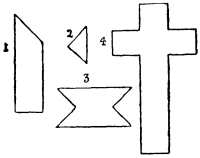
242. Cut out of a piece of card five pieces similar in shape and proportion to the annexed figures.
These five pieces are then to be so joined as to form a cross like that represented by 4.
Irish Counting.
An Irishman who had lately arrived in the colony was employed as handy man at one of our large suburban mansions. The lady of the house, hearing that some midnight thief had walked off with some of her prize poultry, desired Pat to count them as speedily as possible and to inform her how many there were; he accordingly left off cleaning the buggy, and proceeded to enumerate the feathered bipeds. The lady, getting impatient of waiting for him, repaired to the poultry yard, and noticing him chasing a small chicken, enquired, “Pat, whatever are you doing!” when the Irishman replied; “I’ve counted all the chickens except this one; but the little varmint won’t stand still till I count him.”
THE JEW “JEWED.”
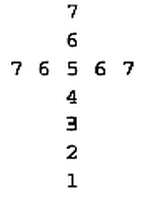
243. An old Jew took a diamond cross to a jeweller to have the diamonds re-set, and fearing that the jeweller might be dishonest he counted the diamonds, and found that they numbered 7 in three different ways. Now, the jeweller stole two diamonds, but arranged the remainder so that they counted 7 each way as before. How was it done?
244. A person wishing to enclose a piece of ground with palisades found that if he set them a foot apart that he should have too few by 150, but if he set them a yard apart he should have too many by 70. How many had he?
245. A mechanic is hired for 60 days on consideration that for each day he works he shall receive 7s. 6d., but for each day he is idle he shall pay 2s. 6d. for his board, and at the end he receives £6. How many days did he work?
246. Take one from nineteen and leave twenty. [Pg 93]
THE CAMEL PROBLEM.

247. An Arab Sheik, when departing this life, left the whole of his property to his three sons. The property consisted of 17 camels, and in dividing it the following proportions were to be observed:—
The oldest son was to have one-half of the camels, the second son one-third, and the youngest son one-ninth; but it was provided that the camels were not, on any account, to be injured, but to be divided as they were—living—between the three sons.
Thereupon, a great argument ensued. The eldest son claimed 8½ camels. The second insisted upon receiving 5⅔ of a camel; while the youngest son would not be comforted with less than 1 8⁄9 of a camel. The Cadi (or Judge) happened to appear on the scene. To him the matter was explained. Without a moment’s hesitation he gave his decision—a decision by which the claims of all three contestants were fully satisfied.
How did the Cadi settle this knotty question?
248. A grocer has 6 weights—each one twice as much as the one before it in size. If he weighed the first five against the largest, it (the largest) would only be 2 lbs. heavier than the combined weights of the rest. What are the weights?
249. A squatter said to a new manager, whom he wished to test in arithmetic: “I have as many pigs as I have cattle and horses, and if I had twice as many horses I should then have as many horses as cattle, and I should also have 13 more cattle and horses than pigs.” How many of each had he?
[2] Feet.
251. Two boys, meeting at a farmhouse, had a mug of milk set down to them; the one, being very thirsty, drank till he could see the centre of the bottom of the mug; the other drank the rest. Now, if we suppose that the milk cost 4½d., and that the mug measured 4 inches diameter at the top and bottom, and 6 inches in depth, what would each boy have to pay in proportion to the milk he drank? [Pg 94]
Weight-for-Age Problem.
252. There are 6 children seated at a table whose total ages amount to 39 years. Tom, who is only half the age of Jack (the oldest) is seated at the top, with Bob—who is a year older than him—next; whilst Fred, who is four-fifths the age of Jack, is at the foot with James, who is 1 year younger than Jack, next, him; the youngest, who is a baby, is one-eighth the age of her brother Fred. Find the ages of each, and weight of Fred, and by placing him third from the top his initial and surname. You must express the ages in words, and use the initial letters.
254. Put 4 figures together to equal 30, and the same figures to equal 40.
255. A Salvation Army captain took up a collection, his lieutenant took up another; if what the captain took up was squared and the lieutenant’s added the sum would be 11d.; if what the lieutenant took up was squared and the captain’s added the sum would be 7d. What was the amount of the collection?
256. Find a number which, if multiplied by 17, gives a product consisting only of 3’s.
THE “FOWL” PROBLEM.
257. If a hen and a half lay an egg and a half in a day and a half, how many eggs will 6 hens lay in 7 days?
258. Tom and Bill work 5 days each. Tom has as much and half as much per day as Bill. The total amount of their wages for the 5 days is £1 17s. 6d. What are their respective wages per day?
259. How many ¼ inch cubes can be cut out of a 2½ inch cube? [Pg 95]
| miles. | furl. | po. | yds. | ft. | in. | |
| From | 1 | 0 | 0 | 0 | 0 | 0 |
| Subtract | 7 | 39 | 5 | 1 | 5 |
THE SQUARE PUZZLE.
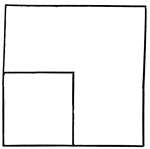
261. A man has a square of land, out of which he reserves one-fourth (as shown in the diagram) for himself. The remainder he wishes to divide among his four sons so that each will have an equal share and in similar shape with his brother. How can he divide it?
Although this is a very old puzzle it is often the cause of much amusement.
GENEROUS.
262. A gentleman, having a certain number of shillings in his possession, made up his mind to visit 17 different barracks and treat the soldiers, and he did so in the following manner:—On going into the first barracks, he gave the sentry one shilling and then spent half of his shillings in the canteen amongst the soldiers, and on coming out of barracks again he gave the sentry another shilling; he repeated the same until he had finished with the seventeenth barracks, and had no more shillings left. How many had he when he commenced?
263. What part of 3 is a third part of 2?
264. Make 91 less by adding two figures to it.
265. If a church bell takes two seconds to strike the hour at 2 o’clock, how many seconds will it take to strike 3 o’clock?
THIS CATCHES EVERYBODY.
Ask a friend how many penny stamps make a dozen? He will reply, “Why, twelve, of course.” Then ask again, “Well, how many half-penny ones?” He is almost sure to reply, “Twenty-four.”
Before he settles his account with nature, man charges the debit of his profit and loss account to Fate, but the credit he takes to himself. [Pg 96]
THE PUZZLE ABOUT THE “PROFITS.”
Perhaps there is no form of commercial calculation so confusing and so little understood as that of mercantile profits. It might surprise many to state, nevertheless it is perfectly true, that it is impossible to buy goods and sell them to show a profit as great as 100 per cent.
The correct method to calculate profit is to reckon on the return—the price received for the goods sold—not on the cost price, and as it is impossible to sell goods at 100 per cent. discount, so also goods cannot be sold to show that percentage of profit, unless they actually cost nothing.
Some time ago, in New Zealand, a well-known boot manufacturer had a “GREAT DISCOUNT SALE.“ He had large posters displayed on the windows of his shops, and advertisements in the newspapers, announcing the fact that 5s. in the £ would be allowed as discount to all customers. The profit he usually obtained in the ordinary way of trade was 25 per cent., and having had a good season, he was prepared to sell off the balance of his stock at cost price. The selling price of his goods was marked in plain figures. A pair of boots which cost him 8s. was marked 10s., thus showing a profit of 2s., which he considered to be 25 per cent. (2s. being a quarter of 8s.) Instructions were issued to all his employees engaged in selling to deduct a quarter from the marked price, the result being that a pair of boots which cost 8s., and marked 10s., was being sold at 7s. 6d. (2s. 6d., the quarter of the marked price being deducted from 10s.) Although he imagined he was getting 25 per cent. profit, he was in reality receiving only 20 per cent. It was not long before the posters were altered, announcing that 4s. in the £ would be allowed to his customers.
The following question was asked some little time ago;—If a chemist sold a bottle of medicine for 2s. 6d., which cost him 2½d., what percentage would be his profit?
Many work out the problem and answer 1100 per cent., but this answer is incorrect. He received 2s. 6d. for that which cost him 2½d., accordingly there was a profit of 2s. 3½d. We must now find out what percentage is the latter amount of the selling price, 2s. 6d., and we discover that it is 91⅔ per cent.
266. A pork butcher buys at auction £100 worth of bacon at 4d. per lb. and sells it at 8d. per lb.; also £100 worth at 8d. per lb., which he sells for 4d. per lb. Does he lose or gain? And if so how much.
“THE JUMPING FROG.”
267. A frog, sitting on one end of a log eight feet long, starts to jump into a pond at the opposite end. With his first jump he clears half the distance, the second jump half the remaining distance, and so on. How many jumps does he take before entering the pond? [Pg 97]
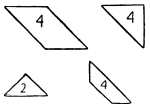
OBLONG PUZZLE.
268. Cut out of a piece of cardboard fourteen pieces of the same shape as those shown in the diagram—the same number of pieces as is there represented—and then form an oblong with them.
269. If a man can load a cart in five minutes, and a friend can load it in two and a half minutes, how long will it take them both to load it, both working together?
270. A gentleman on being asked how old he was, said that if he did not count Mondays and Thursdays he would be 35. What was his actual age?
TOO SMART FOR DAD.
“Pa,” said a boy from school, “How many peas are in a pint?” “How can anybody tell that, foolish boy?” “I can every time. There is just one ‘p’ in pint the world over.” He was sent off to bed early.
SIMPLE PROPORTION.
271. If it takes three minutes to boil one egg, how long will it take to boil two?
“PUNCH’S” MONEY VAGARIES.
The early Italians used cattle as a currency instead of coin (thus a bull equals 5s.) and a person would send for change for a thousand pound bullock, when he would receive 200 five pound sheep. If he wanted very small change there would be a few lambs amongst them. The inconvenience of keeping a flock of sheep at one‘s bankers’, or paying in a short-horned heifer to one’s private account led to the introduction of bullion.
As to the unhealthy custom of sweating sovereigns, it may be well to recollect that Charles I., the earliest Sovereign, who was sweated to such an extent that his immediate successor, Charles II., became one of the lightest Sovereigns ever known in England.
Formerly every gold watch weighed so many carats, from which it became usual to call a silver watch a turnip.
The Romans were in the habit of tossing their coins in the presence of their legions, and if a piece of money went higher than the top of their Ensign’s flag it was presumed to be “above the standard.” [Pg 98]
“MARCH ON! MARCH ON!”
272. An army 25 miles long starts on a journey of 50 miles, just as an orderly at the rear starts to deliver a message to the General in front. The orderly, travelling at a uniform speed, delivers his message and returns to the rear, arriving just as the army finishes the journey. How many miles does the orderly travel?
“WITH A LONG, LONG PULL.”

273. If eight men are engaged in a tug-o’-war, four pulling against four, on a continuous rope, and each man is exerting a force of 100 lbs., what strain is there at the centre of the rope?
“FIND OUT.”
274. A gentleman in a train with a boy got into conversation with a stranger, who asked him the lad’s age. The boy quickly replied, “This gentleman, who is my uncle, is twice as old as me, but the sum of the figures in my age are twice the sum of those in his.” What was the age of each?
275. One of our squatters who had made his fortune in the “good times” determined to sell his run and spend the rest of his days in the old country. A new chum, possessing considerable wealth, and desirous of settling down in Australia, hearing of the squatter’s intention, interviewed him with the object of purchasing, when the following conversation ensued:—
New Chum: “How big is your run? What’s its area?”
Squatter: “Well, I’m blessed if I know, but I can tell you it’s perfectly square and enclosed with posts and rails. Each of the rails is 9 ft. long.”
New Chum: “Oh, then, is it what you call a three-railed paddock?”
Squatter: “Yes, that’s so, and now I remember that the number of rails in my run is equal to the number of acres. If you like you can take a horse and ride round and count the rails, then you will know the area.” This advice the new chum acted upon.
Find out the length of his ride and the area of the run. [Pg 99]
A Federal Problem.
It is well known to our readers that paper money—such as pound notes—issued in one colony are depreciated in another; thus a one pound note of N.S.W. is only worth 19s. 6d. in Victoria, and vice versa. Some time ago a rather ’cute individual in Wodonga, on the Victorian side of the border, bought a drink in a local hotel with a Victorian note, and received in change a N.S.W. note, which was worth then and there only 19s. 6d.; he thereupon crossed the Murray to Albury on the New South Wales side, bought another drink for sixpence with his N.S.W. note, and received a Victorian note equal to 19s. 6d. in change. He travelled backwards and forwards during the day, getting his twentieth and last drink in Albury, on the N.S.W. side, whereupon he returns to Wodonga with a Victorian pound note still to his credit. He thus paid for all his drinks, which amounted to ten shillings. Who lost the money?
We cannot advise readers to “go thou and do likewise,” for the simple reason that such a proceeding would now be impossible, as exchange is no longer charged in the two towns mentioned. It is not until we get further from the border that the levy is made.
Doing Two Things at Once.
An inspector was examining a school in a country district some distance from a railway station. He was afraid of losing his train, so hurrying with his work he tried to do two things at once. Standing in the doorway, he gave out dictation to Class III. in the main room, and at the same time gave out a sum to Class IV. in an adjoining room, jerking out a few words alternately.
The sum was “If a couple of fat ducks cost 19s., how many can he get for £72 10s. 9d.” The dictation for Class III. began “Now as a lion prowling about in search, &c.” Of course the poor children heard both, and got a bit mixed. One little girl’s dictation began “Now a couple of ducks prowling about in search of a lion who had lost 19s., &c.” While a Class IV. lad was scratching his head over the following sum “If 72 couples of fat lions cost 19s., how much prowling could be got for £72 10s. 9d.”
TWO CALENDAR CATCHES.
Ask a person if Christmas Day and New Year’s Day come in the same year. The answer generally given is “Of course not, Christmas comes in this year, and New Year’s Day in the next.”
Another question that often puzzles many. Have we had more Christmas days than Good Fridays? The usual answer is “No, both the same.” [Pg 100]
276. A brass memorial tablet in honour of the late Sir Charles Lilley has been fixed in the centre of the eastern wall of the Brisbane Grammar School Hall. The enthusiasm displayed by Sir Charles in the cause of education generally, and his work on behalf of the Grammar School, make this commemoration particularly appropriate. The following is the inscription, to translate which should prove a capital exercise to all Latin scholars. The tablet measures 50 inches by 30 inches.
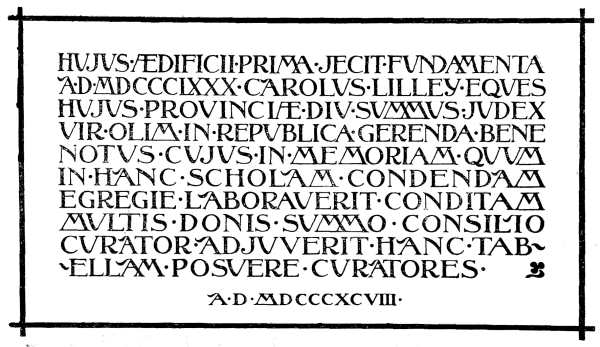
MEMORIAL TABLET TO THE LATE SIR CHARLES LILLEY
It may be added that the lettering of the plate was designed by Mr. R. S. Dods, architect, and the engraving was done in Brisbane by Messrs. Randle Bros., the well-known engravers, of Elizabeth Street. [Pg 101]
A Puzzle in Book-keeping.
277. A firm appointed an agent to do business on their account, and gave him £32 17s. in cash for expenses, &c., and also supplied him with a stock of goods, the value wholesale being £57 14s.; while in a distant town he bought a job lot of goods for £59 19s., which he paid cash for out of what he had realised on his first stock. He still continued to sell, but very soon after the firm called him in, and desired him to close his account and hand in a full statement.
His total retail sales amounted to £102 17s., and he returned goods to the value of £31 17s., his expenses had been £25.
Question—What does the firm owe the agent, or the agent owe the firm?
The Agent’s Statement Being—
| Cash | £ 32 | 17 |
| Goods | 57 | 14 |
| Paid for Goods | 59 | 19 |
| Cash Sales | 102 | 17 |
| Goods Returned | 31 | 17 |
| Expenses | 25 | 0 |
This puzzle first appeared in “How to Become Quick at Figures,” the answer being withheld. It is a record of transactions that actually occurred in America, which were the subject of litigation. Although we received thousands of replies, not more than 5 per cent. were correct. It is a question that individuals not conversant with book-keeping would be as likely to solve correctly as the expert. For the convenience of those who are unacquainted with American money we have been obliged to substitute £ s. d., and would advise our readers to attempt a solution before referring to the answer.
In bringing “The Puzzle King” to a conclusion, the author can only express the hope that he has been successful in his endeavour to make it not only an amusing work but also a useful one.
The impossibility of making a book of this nature perfect is fully recognised, and corrections or contributions will be cordially received, and the contributor liberally remunerated.
All communications must be sent to 44 Pitt Street, Sydney, addressed to the author, who tenders to all readers of “The Puzzle King”—
| 485 | 463 | 475 | 465 |
| 461 | 467 | 487 | 473 |
| 483 | 477 | 457 | 471 |
| 459 | 481 | 469 | 479 |
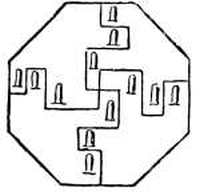
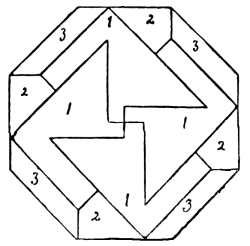
| The | first | £15 |
| " | second | 8 |
| " | third | 10 |
| " | fourth | 6 |
| The man had | £39 | |
| A | B | C | D | E | F | G | H |

Fig. 1
| 47 | 58 | 69 | 80 | 1 | 12 | 23 | 34 | 45 |
| 57 | 68 | 79 | 9 | 11 | 22 | 33 | 44 | 46 |
| 67 | 78 | 8 | 10 | 21 | 32 | 43 | 54 | 56 |
| 77 | 7 | 18 | 20 | 31 | 42 | 53 | 55 | 66 |
| 6 | 17 | 19 | 30 | 41 | 52 | 63 | 65 | 76 |
| 16 | 27 | 29 | 40 | 51 | 62 | 64 | 75 | 5 |
| 26 | 28 | 39 | 50 | 61 | 72 | 74 | 4 | 15 |
| 36 | 38 | 49 | 60 | 71 | 73 | 3 | 14 | 25 |
| 37 | 48 | 59 | 70 | 81 | 2 | 13 | 24 | 35[Pg 104] |
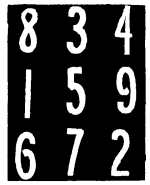

| 39 |
| 12 |
| 78 |
| 39 |
| 468 |
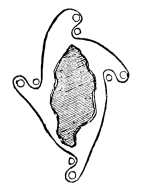
| 621 | 642 | 627 |
| 636 | 630 | 624 |
| 633 | 618 | 639 |
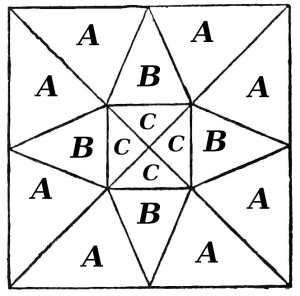
| 987654321 = 45 | or | 555555555 = 45 |
| 123456789 = 45 | 99999 = 45 | |
| 864197532 = 45 | 555455556 = 45 |
| The 1st part | 8 | add | 2 = 10 |
| " 2nd " | 12 | subtract | 2 = 10 |
| " 3rd " | 5 | multiply by | 2 = 10 |
| " 4th " | 20 | divide by | 2 = 10 |
| 45 | |||
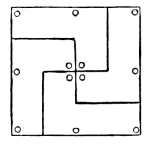
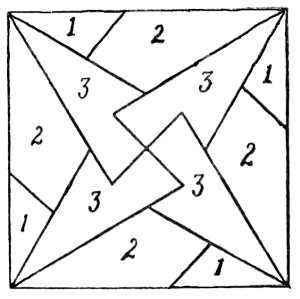
| 32 | or | 46 | or | 95 72⁄36 | or | 14 |
| 57 | 35 | 1 8⁄4 | 76 | |||
| 89 | 17 | 100 | 5 | |||
| 1 | 98 | 3 | ||||
| 6 | 2 | 98 | ||||
| 4 | 100 | 2 | ||||
| 100 | 100 |
| 56 | or | 20 | or | 40 |
| 24 | 8 | 36 | ||
| 80 | 7 | 15 | ||
| 1 | 35 | 7 | ||
| 9 | 46 | 98 | ||
| 3 | 19 | 2 | ||
| 7 | 100 | 100 | ||
| 100 |
| 3 Officers, 2s. each and 4d. each | 7s. 0d. |
| 4 Non-coms, 1s. 6d. each | 7s. 4d. |
| 8 Privates, 1s. 3d. | 12s. 8d |
| Amount | £1 7s. 0d. |
| ⅓ plus ¼ plus ⅕ plus ⅙ = | 20 plus 15 plus 12 plus 10 | = | 57 |
| 60 | 60 |
| s. | |||
| 20 x 20 = | 400 div. 57 = | 7 1⁄57 | to 1st son |
| 15 x 20 = | 300 div. 57 = | 5 15⁄57 | " 2nd " |
| 12 x 20 = | 240 div. 57 = | 4 12⁄57 | " 3rd " |
| 10 x 20 = | 200 div. 57 = | 3 29⁄57 | " 4th " |
| 20s. | |||
| 1st Company, | £2400 |
| 2nd " | 1800 |
| 3rd " | 1600 |
| 4th " | 1500 |
| £7300 | |

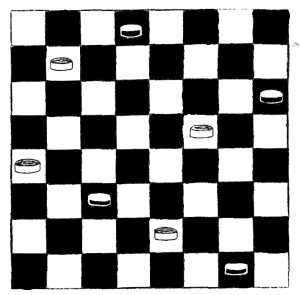
| Wife | £4650 |
| Son | 6200 |
| Eldest daughter | 3100 |
| Youngest " | 1550 |
| Total | £15,500 |
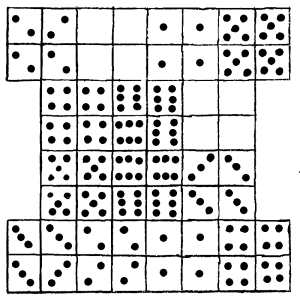
| The lazy sundowner | 2 days at 2 hours per day = | 4 hours |
| " second " | 4 " " 4 " " " = | 16 " |
| " third " | 6 " " 6 " " " = | 36 " |
| " fourth " | 12 " " 12 " " " = | 144 " |
| 200 hours | ||


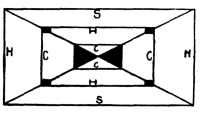
Fig. 1—Represents the brick and the method of cutting it.
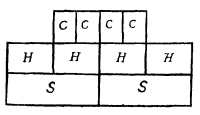
Fig. 2—Represents the face of the wall showing the area of brick when cut. It has been necessary to produce this figure on half-scale to that of Fig. 1.
The Knight Move.
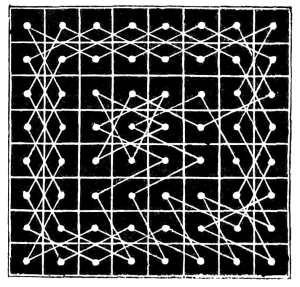
| 8 | 256 | 2 |
| 4 | 16 | 64 |
| 128 | 1 | 32 |
| Even, | £6 against £6— | £12 |
| 2 to 1, | £8 against £4— | £12 |
| 3 to 1, | £9 against £3— | £12 |
| £13 | Received. | |
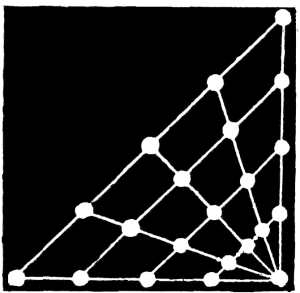
| SIX | IX | XL | |
| IX | X | L | |
| —————— | |||
| S | I | X | |

He must cut the piece of veneer as
shown by the middle figure, when he
will be able to get his two ovals.
| Table | Full. | Half-full. | Empty. | |
| 1 | | | 2 | 3 | 2 |
| 2 | | | 2 | 3 | 2 |
| 3 | | | 3 | 1 | 3 |
| 1 | | | 3 | 1 | 3 |
| 2 | | | 3 | 1 | 3 |
| 3 | | | 1 | 5 | 1 |
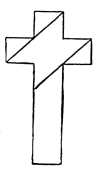
| Jack, | 10 yrs. | Tom | FIVE | Tom | Five |
| James, | 9 " | Bob | Six | Bob | Six |
| Fred, | 8 " | Jack | Ten | Fred | Eight |
| Bob, | 6 " | Baby | One | Jack | Ten |
| Tom, | 5 " | James | Nine | Baby | One |
| Baby, | 1 " | Fred | Eight | James | Nine |
| 17 ) | 33 | ( 196078431372549 |
| 17 |
| To prove it:— | 196078431372549 |
| 17 | |
| Proof— | 3333333333333333 |
| 28 eggs. Method: | 1½ hens lay | 1½ eggs in | 1½ days |
| 1½ " " | 3 " " | 3 " | |
| 3 " " | 6 " " | 3 " | |
| 3 " " | 2 " " | 1 " | |
| 6 " " | 4 " " | 1 " | |
| 6 " " | 28 " " | 7 " |
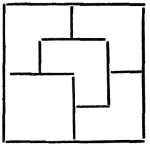

DIDDAMS PRINTER, BRISBANE.
Transcriber's Notes:
The cover image was created by the transcriber and is placed in the public domain.
Antiquated spellings have been preserved.
Typographical errors have been silently corrected but other variations in spelling and punctuation remain unaltered.
Answers are provided at the end of the book to numbered questions, however in the original text, numbers 237 to 241 were omitted for some reason.